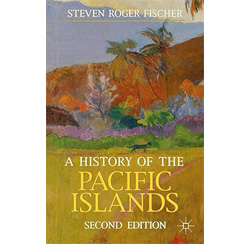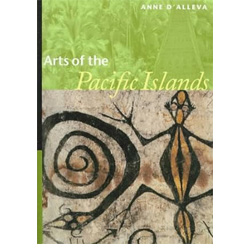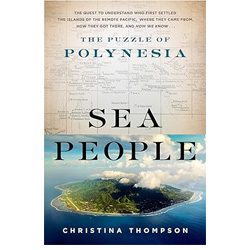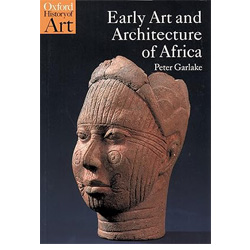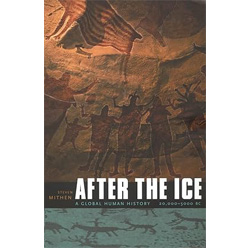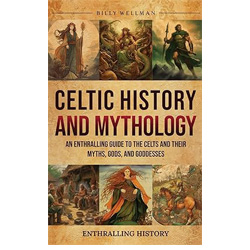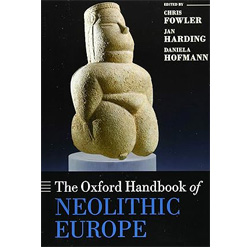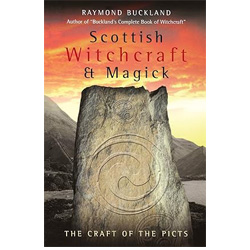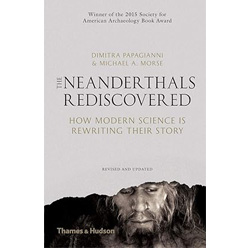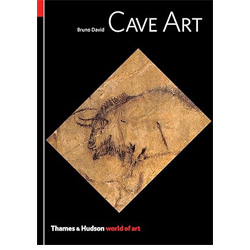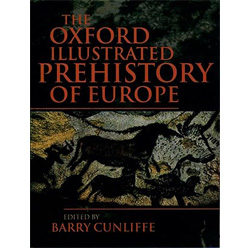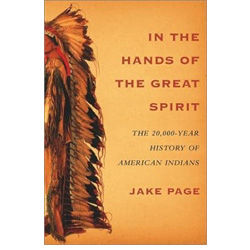- Jewelry
- Inspiration
- Our imagination
- Birthstones
- Celebrating with Eternal Flowers
- Druids and druidesses
- Flower meanings
- History, archeology jewelry
- History and healing properties of metals
- History and healing properties of stone
- Illumination jewelry
- Japanese symbols
- Maya calendar jewelry
- Stone color symbolism
- Stones catalogue
- Wedding anniversaries
- Searches a theme on the site
- Good Deals
- Paintings
- About
- Contact
JEWELRY
- Anklet
- Bracelets
- Brooches
- Cufflinks
- Earrings
- Pendants & Necklaces
- Rings
- Draw your jewelry
- How to clean your jewel
- Metal we used
INSPIRATION
- Our imagination
- Birthstones
- Celebrating with Eternal Flowers
- Druids and druidesses
- Flower meanings
- History, archeology jewelry
- History and healing properties of metals
- History and healing properties stones
- Illumination jewelry
- Japanese symbols
- Maya calendar jewelry
- Stone color symbolism
- Stones Catalogue
- Wedding anniversaries
- Searches a theme on the site

Jewelry: History, Archaeology, and Replicas
Ancient cultures, with their wealth and mysteries, exert a profound influence on our imagination, fueling our creativity. The remnants and artifacts they left behind, silent witnesses of a bygone era, continue to captivate and inspire, providing an endless source of ideas and motifs for jewelry. These treasures from the past, whether they be works of art, symbols of ancient beliefs, or legendary tales, are gateways to forgotten worlds, vanished civilizations, and distant cultures. They invite us to explore and reinterpret ancestral traditions and techniques, adapting them to our time and sensibilities while preserving their essence and authenticity. By drawing from this rich heritage, we can create unique and timeless pieces that tell ancient stories, evoke deep emotions, and embody the art and beauty of their era.
To explain our jewelry inspired by different civilizations, we begin our journey through history by moving from the abstract to the tangible, from allusions to history to a more direct representation, that of archaeological replicas.
Each piece of jewelry is a story to tell, a memory to preserve, a heritage to pass on.
History inspired jewels
Our jewelry bears witness to history, fragments of time and space that capture the essence of different eras and cultures. Each piece is a story in itself, a journey through ages and continents, a tribute to the richness and diversity of humanity.
Crosses, fleurs-de-lis, and shields evoke the medieval period, an era of knights and castles, faith and war. The arabesque leaf patterns recall the sumptuous tapestries of the Baroque period, a time of grandeur and splendor, refinement and decadence. The Greek key and diamond motifs featured in several of our creations, along with the floral and animal designs of Otomi textiles, draw from Mexican culture, a culture rich in traditions and symbols, colors and textures, stories and legends. Spirals evoke the Neolithic and Celtic periods, times of mystery and magic, rituals and beliefs, and a deep connection to nature and the cosmos.
A quick glance at our jewelry catalog will allow you to quickly discern the influences we’ve drawn upon.
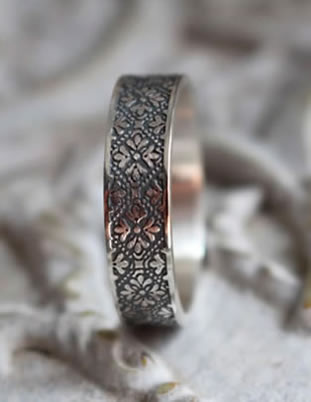
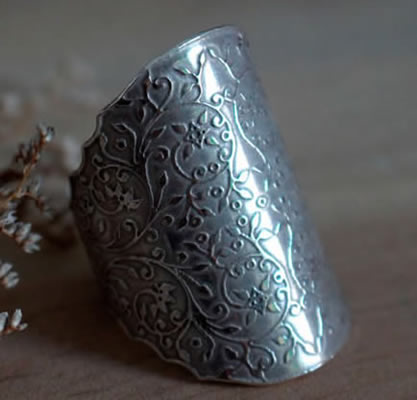
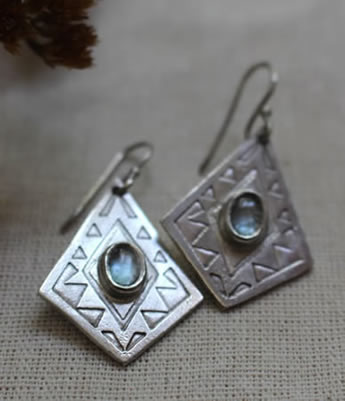
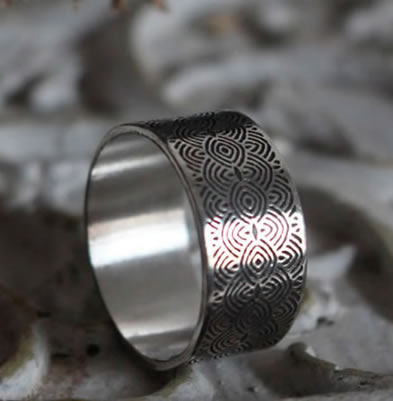
Here is a list of links to get access to these themes:
Jewelry echoing the past or interpreted history
There are stories from the past that transcend the visual and are passed down orally, from generation to generation. These tales, often in the form of proverbs, maxims, or quotations, resonate through the centuries and are deeply embedded in our culture. They are like precious gems, treasures of wisdom and knowledge, which we love to revisit and refine, adapting them to our time and our aesthetic sensibilities.
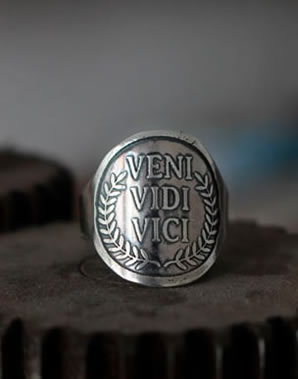
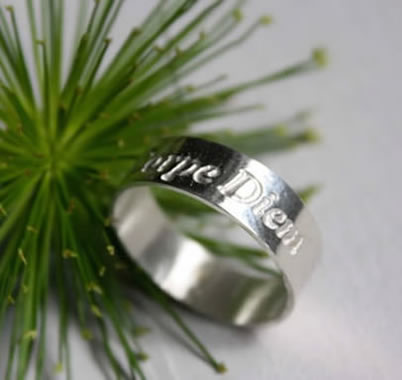
In the abstract realm, and particularly in the sciences, simplifying interpretation is often necessary to make concepts more tangible. For example, the complexity of mathematics can be approached more concretely through the Fibonacci ring, named after the famous mathematical sequence. This sequence, represented in the form of a spiral, appears in numerous natural phenomena and living structures, offering a visual and tangible perspective of the beauty and harmony of mathematics in the world around us.
The Fibonacci spiral, beyond its geometric representation, symbolizes how mathematical order and harmony are present in the apparent chaos of nature, from the pattern of a nautilus shell to rotating galaxies. The ring also reflects the idea that everything in the universe is interconnected and governed by universal mathematical principles.
The Vitruve ring, inspired by Leonardo da Vinci’s famous drawing, is an ode to the harmony and perfection of human proportions. This drawing, based on the writings of the Roman architect Vitruvius, explores ideals of beauty and balance in the human body. By incorporating this design, the Vitruvian ring becomes a symbol of the aspiration for perfection and harmony, reminding the wearer of the importance of balance and symmetry in life.
Another example is the Darwin ring, inspired by Charles Darwin’s theory of human evolution. It is a tribute to the complexity and diversity of life on Earth. This theory, which revolutionized our understanding of the origins and diversity of species, is reflected in the design of the Darwin ring.
The ring, with its evolving human forms, serves as a reminder of life’s constant adaptation and transformation, and of the beauty found in the diversity and uniqueness of every living being. The Darwin ring also embodies the idea that each individual, like every species, is in continuous transformation, evolving with grace and resilience in a perpetually changing world.
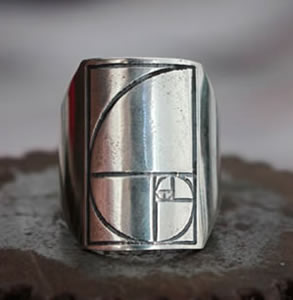
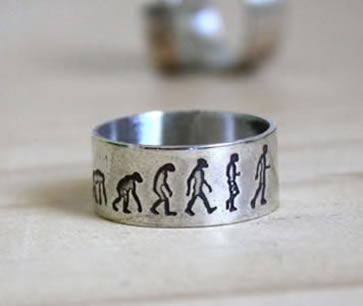
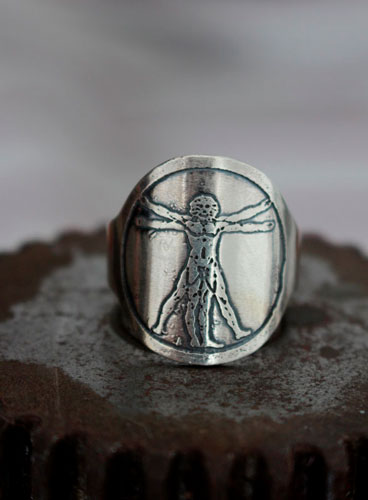
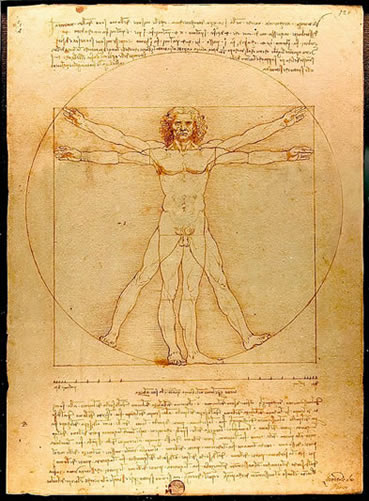
To search for these jewelry pieces:
To take a closer look:
Jewelry reproduction of archeological objects
The creation of jewelry inspired by archaeological artifacts is a journey through time, a dive into the world of ancient civilizations that shaped our cultural heritage. Each piece begins with a passionate exploration, which may take the form of in-depth research in specialized texts or visits to museums where every artifact, no matter how modest, becomes a silent witness to a bygone era. We pay particular attention to lesser-known or rarely showcased archaeological objects, as they convey a raw authenticity and mysterious aura often lost in mass reproductions.
We favor these unique pieces, far removed from mass-produced historical jewelry. Each creation must embody a message, evoke an emotion, and carry with it a fragment of history, both for you and for us. We believe that every piece of jewelry has a soul, one that is infused with centuries of heritage and tradition.
However, reproducing these artifacts is far from a linear process. Some promising projects may never come to fruition. From the initial stages—sketching and design—it is possible that the visual translation of the artifact does not remain faithful to the original idea. Even when a piece passes this stage, the manufacturing process itself can present unexpected challenges: complex details to replicate, shapes that do not adapt well to the format... Craftsmanship requires both patience and precision.
Sometimes, a project results in a finished piece, and it is with pride that we welcome these creations into our collection. Yet many projects are abandoned along the way. Only the jewelry that meets our exacting standards of quality, honoring both history and modern aesthetics, finds its place in our store. Each piece then represents not only a technical achievement but also an emotional one, carrying within it the spirit of history and the soul of vanished civilizations.
Jewelry inspired by Australian aborigines
Australia, with its diverse landscapes and rich history, is a treasure trove of archaeological and cultural artifacts, offering a fascinating glimpse into the lives of the Indigenous peoples who have inhabited the continent for millennia. Among these peoples, the Aborigines stand out for their cultural heritage, deeply rooted in their symbiotic relationship with nature. Their art, particularly rock paintings, serves as a poignant testament to this intimate and spiritual connection with their environment.
These paintings, found in caves or rock shelters, are works of great artistic sophistication. They depict an impressive range of motifs, from animals and plants to hunting scenes and ritual ceremonies. Aboriginal artists used natural pigments, sometimes mixed with water or animal fats, and advanced painting techniques to create expressive and enduring works of art.
These rock paintings are also a means of transmitting knowledge, traditions, and stories. They reflect the depth of Aboriginal culture and its spiritual connection to the land. By studying them, we can gain a better understanding of the richness and complexity of Aboriginal civilization, as well as the importance of preserving and respecting their cultural heritage.

The Kiro Kiro aborigine ritual necklace is a striking example of the deep connection between the Aborigines and their natural environment. Inspired by a rock painting dating back to 10,000 BCE, this necklace serves as a poignant testament to the enduring legacy of Aboriginal culture. The Kiro Kiro rock paintings are renowned for their distinctive anthropomorphic figures, often depicted with ritual accessories such as bags, tassels, and stylized headdresses. These artistic representations are deeply rooted in rituals, initiation rites, and shamanic ceremonies, offering a fascinating insight into Aboriginal spirituality and their sacred bond with the land.
This particular painting stands out for its elegance and refinement in portraying the figures. Every detail is meticulously crafted, reimagining ancestral motifs with a contemporary sensibility. By wearing this necklace, one establishes a tangible link to their ancient traditions and beliefs. This piece of jewelry is a living connection to an ancient and venerable culture, allowing the wearer to immerse themselves in the history and spirituality of Australia’s first inhabitants.
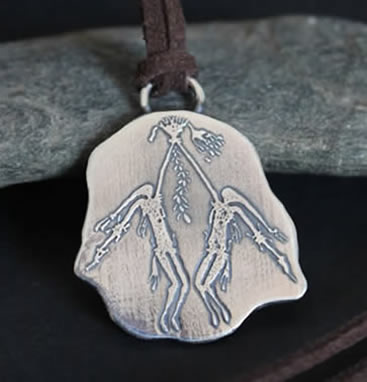
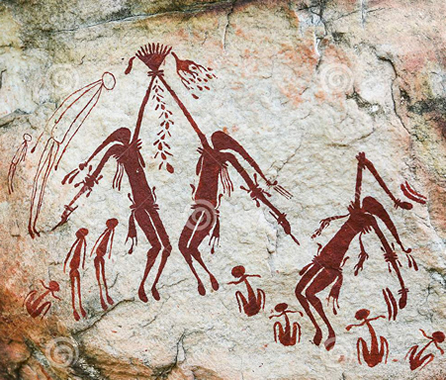
To deepen your knowledge of the art and history of Australia’s Aboriginal people, we recommend the following books:
Jewelry from Pacific Islands
Oceania, often associated with its paradisiacal islands and exotic landscapes, is a region rich in cultural traditions and craftsmanship. This vast collection of Pacific islands extends beyond its natural beauty; it is also the cradle of ancient and fascinating cultures that have left an indelible mark on local craftsmanship. While exploring this region, we were particularly captivated by the traditional objects and motifs that reflect the imagination and beliefs of Oceanian peoples.
Maori tattoos, in particular, are iconic elements of Oceanian culture. These intricate designs, often rendered in black ink, carry deep meanings and are imbued with ancestral stories. Each motif, whether spirals, geometric shapes, or stylized representations of animals, symbolizes aspects of Maori culture such as bravery, family heritage, and connections with ancestors. Inspired by these tattoos, we have designed jewelry that respectfully and aesthetically incorporates these motifs.
Beyond tattoos, Oceania offers a wide variety of traditional objects that inspire our creations. For example, jewelry made from shells, shark teeth, or carved wood plays an important role in ceremonies and rituals. Each material has its own significance and is used to symbolize natural elements or spiritual forces.
Our research into Oceanian jewelry also led us to discover other forms of craftsmanship, such as necklaces and bracelets adorned with mother-of-pearl or precious stones, which are not only objects of beauty but also serve as social and spiritual bonds within communities.
By integrating these cultural influences into our creations, we strive to pay homage to the art and traditions of the Oceanian peoples, while creating unique pieces that celebrate and perpetuate their rich heritage.

A captivating example from our collection is inspired by a traditional shield from the Elema culture, originating from the Gulf of Papua, New Guinea. This shield, with its distinctive "U" shape, is carved from wood and vibrant with colorful pigments, drawing attention with its elaborate geometric patterns and triangular friezes. What makes it particularly fascinating are the multiple eyes carved into its surfaces, each carrying profound symbolic meanings.
In Elema culture, eyes on shields and other ritual objects often symbolize vigilance, protection, and a connection with ancestral spirits. The geometric patterns represent elements of nature and mythological stories, serving to protect and guide the bearer during ceremonies and rituals. The use of bright colors and stylized shapes reflects the artistic skill and cultural richness of the Elema people.
Inspired by this iconic piece of art, we created a pair of earrings named "Oceanian shield." By reinterpreting the shield’s motifs, we aimed to capture the essence of this unique piece while adapting it to a modern and accessible format.
This shield, a treasure of traditional Oceanian art, is currently housed in the prestigious Brooklyn Museum Collection in the United States. It remains a fascinating testament to the artistic and cultural heritage of the Pacific Islands.
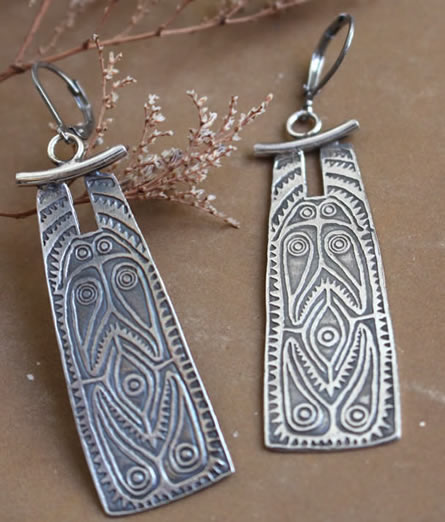
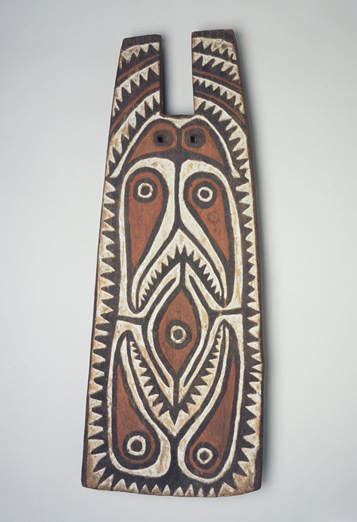
To deepen your knowledge of the art and history of Pacific Island, we recommend the following books:
Jewelry inspired by the Roman and Greek antiquity
The ancient worlds of Greece and Rome are among the most renowned in human history, and their legacy is of unparalleled richness. Infused with mythology and imagination, this heritage continues to captivate minds through the ages. The epic tales of ancient Greece, such as the Iliad and the Odyssey, along with the Roman legends of Romulus and Remus, have shaped our understanding of history and culture. The gods and heroes of these civilizations have inspired works of art, theater, poetry, and novels, and their influence is still felt today in our language, philosophy, and politics.
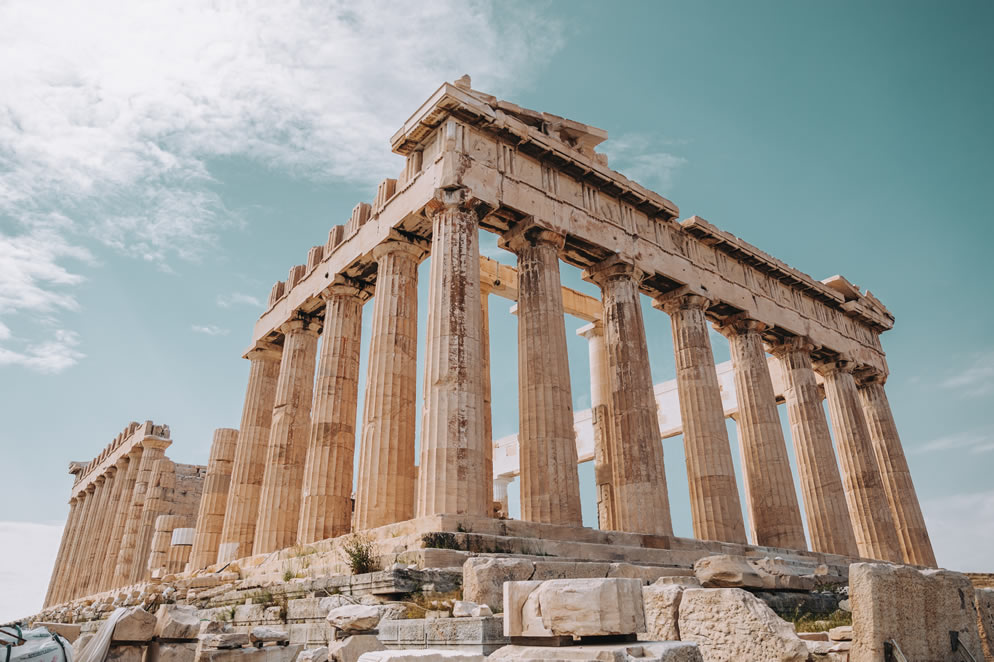
The Spartan shields cufflinks embody the legacy and bravery of the warriors from the city of Sparta, whose battlefield reputation is legendary. Custom-designed, these cufflinks meticulously recreate the famous Spartan shield, an iconic symbol of their strength and discipline. Every detail is carefully reproduced, from battle marks to engraved patterns, capturing the very essence of Spartan military life.
The Spartan shield, known as the "aspis" or "hoplon," was essential in phalanx combat formations, allowing warriors to protect themselves while forming an almost impenetrable wall. It was often adorned with significant symbols, and in the case of the Spartans, the letter lambda (Λ) was proudly displayed. This letter, representing the region of Laconia, of which Sparta was the center, was not only an emblem of regional pride but also a sign of unity and cohesion among the warriors.
The cufflinks we offer also feature this lambda symbol, paying homage to this ancient tradition and the bravery of the Spartans. By wearing these cufflinks, you not only sport an elegant accessory but also carry a piece of the military and cultural history of ancient Greece. Each piece is a testament to the courage and determination of Spartan warriors, capturing the spirit of their era while providing a touch of modern sophistication.
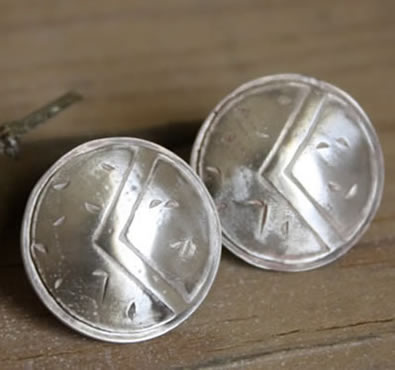
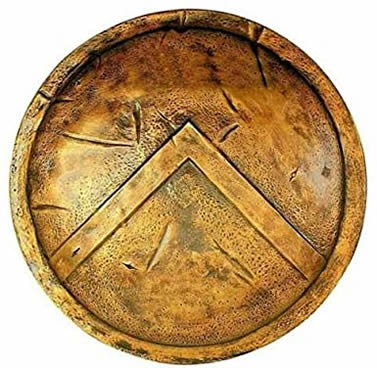
We also had the pleasure of creating the Phaistos pendant, an elegant tribute to the famous ancient disc from which it draws its inspiration. This custom-made piece is directly inspired by the Phaistos Disc, a fascinating artifact discovered during the archaeological excavations of the Minoan palace at Phaistos in Crete. This clay disc, which may date back to the second millennium BCE, is adorned with mysterious symbols engraved using stamps, present on both sides.
The Phaistos Disc is one of the most intriguing artifacts of Minoan archaeology due to the complexity and diversity of the symbols it bears. These symbols, resembling hieroglyphs, have not yet been fully deciphered, and their exact meaning remains a subject of debate among experts. Some theories suggest that these symbols could represent an ancient form of writing or a kind of ritual code, adding an aura of mystery to the object.
Our Phaistos pendant incorporates a stylized segment of the original disc, accompanied by a dendritic agate, carefully selected by our client, evoking the sophistication and mystery of antiquity. By wearing this piece, you carry a slice of history that reflects the grandeur and enigma of ancient civilizations. Every detail of the pendant is designed to capture the spirit of the Phaistos Disc while adding a contemporary touch to this archaeological treasure.
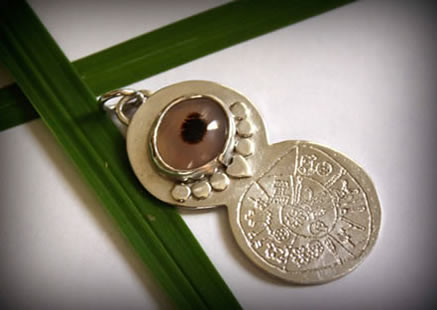
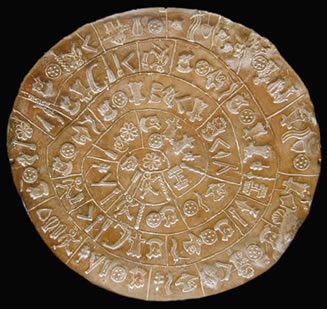
We created the necklace named “The Labyrinth of Knossos” by drawing inspiration from an object that may seem more common than others in our collection, yet whose clean design and powerful symbolism immediately captivated us. It is based on one side of an ancient coin from the city of Knossos, in Crete—a Greek territory steeped in myth and history.
This Cretan coin circulated throughout the Mediterranean basin between 200 and 67 BCE, at a time when Knossos, though in decline, still retained significant cultural influence. One of its faces features a stylized circular labyrinth, accompanied by Greek inscriptions identifying its origin.
In Greek imagination, the labyrinth is a symbol rich in meaning. It evokes the idea of an initiatory quest, as much as danger, death, heroism, and the necessity of a guide—such as Ariadne’s famous thread. To enter the labyrinth is to accept being lost, to face the unknown, and to emerge transformed. Reaching the center and finding the way out symbolizes an inner journey, a path toward knowledge or transformation.
But the labyrinth motif also more concretely refers to the Minoan palaces, especially that of Knossos, whose architecture was said to be so intricate and maze-like that it inspired the myth itself. According to legend, it was here that the architect Daedalus designed an actual labyrinth to imprison the Minotaur—a creature half-man, half-bull, born of Pasiphaë’s cursed love. It is within this setting that one of the most famous stories in Greek mythology takes place: Theseus, the Athenian hero, enters the labyrinth, slays the monster, and manages to escape thanks to the thread Ariadne had given him. What heroism, what an adventure!
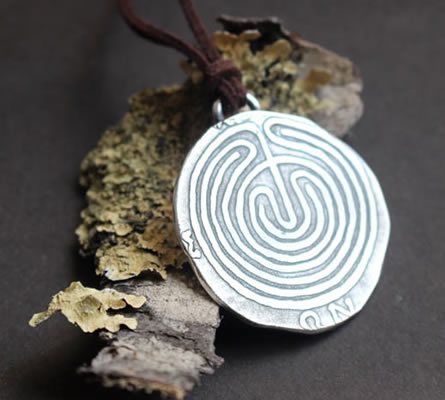
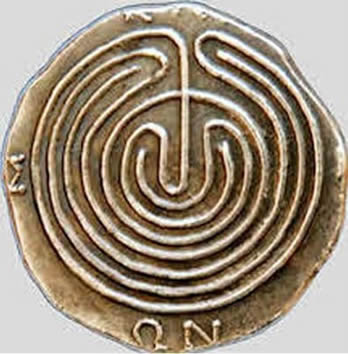
To deepen your knowledge of the art and history of Roman and Greek antiquity, we recommend the following books:
Antique Africa jewelry
Africa is a continent of immense wealth, though it is often treated superficially in our educational curricula. It is a land of many facets, where each region, each country, and each people has its own history, culture, and traditions. From the vast deserts of the Sahara to the tropical rainforests of Central Africa, from the majestic Atlas Mountains to the white sandy beaches of the Indian Ocean, Africa offers an unparalleled geographic and natural diversity. But it is its human richness that is most remarkable: ancient civilizations, diverse languages and dialects, ancestral traditions, and vibrant arts and music.

The Katanga earrings are inspired by a copper axe, an emblematic artifact of the Songye ethnic group from the Katanga region in the Democratic Republic of Congo. These axes, with their unique design, reflect exceptional forging skills, showcasing precise control and a deep understanding of metallurgical techniques. Every detail of these axes, from their shape to their finish, is the result of artisanal mastery passed down through generations.
Beyond their utilitarian function, Katanga axes also held significant symbolic and social value. They were often used as currency in major commercial transactions and as prestigious items in ritual ceremonies. They symbolized wealth, power, and authority within the Songye communities and other ethnic groups in the region.
The distinctive shape of these axes, with their semi-circular blade and often ornate handle, inspired the creation of the Katanga earrings. By reinterpreting this ancestral silhouette, we aimed to capture not only the unique aesthetics of the original artifact but also the cultural depth it represents. These earrings are a celebration of African history and craftsmanship, blending tradition with modernity.
Wearing these earrings means carrying a symbol of strength, history, and cultural memory, reminding us of the importance of copper in the economic and spiritual exchanges of ancient Africa. Their metallic shine pays tribute to the Songye blacksmiths, whose skill and craftsmanship have endured through the ages.
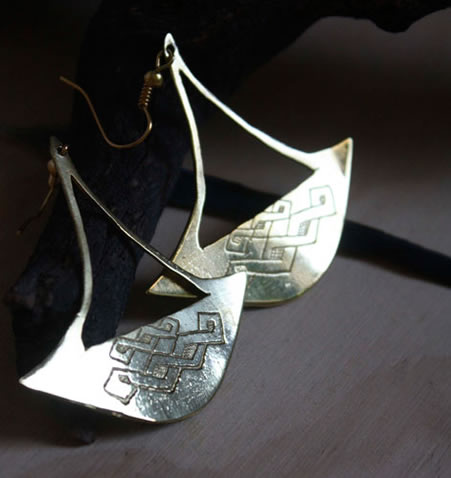
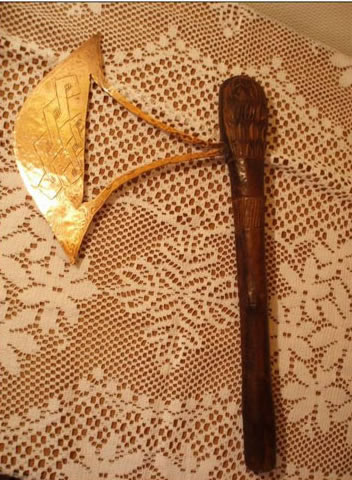
To deepen your knowledge of the art and history of Africa, we recommend the following books:
Norse and Viking culture jewelry
Another captivating culture that has drawn our attention is that of the Nordic tribes. Often referred to as "Vikings," these people were fearless adventurers and warriors who sailed the northern seas and explored distant lands long before the age of great discoveries. Their exploits and legacy have left an indelible mark on history, and their mythology, rich with gods and heroes, continues to inspire epic tales and works of art.
The Nordic tribes also left behind a remarkable material heritage, with finely crafted and beautifully adorned jewelry. These pieces were often decorated with powerful symbolic motifs, such as interlaced knots, animal figures, or representations of deities. The geometric and interwoven forms typical of Viking art symbolized the connection between the spiritual and earthly realms, as well as the eternity of life. Common motifs included dragons, wolves, and serpents, associated with qualities like protection, strength, and resilience.
The use of precious metals like silver and gold, often combined with semi-precious stones such as amber or garnet, reflected the social rank and status of those who wore these pieces. Amulets like Thor’s hammers (Mjölnir) or Christian crosses, worn around the neck or wrist, provided their bearers with divine protection in life and beyond.
It is this rich cultural heritage and aura of mystery that draws us to explore this fascinating civilization further. Our creations draw inspiration from these iconic motifs, reinterpreting them in a contemporary style while respecting the symbolic codes of the era. Wearing one of these pieces allows you to feel the ancestral energy of Nordic warriors and connect with a millennia-old legacy imbued with courage and spirituality.
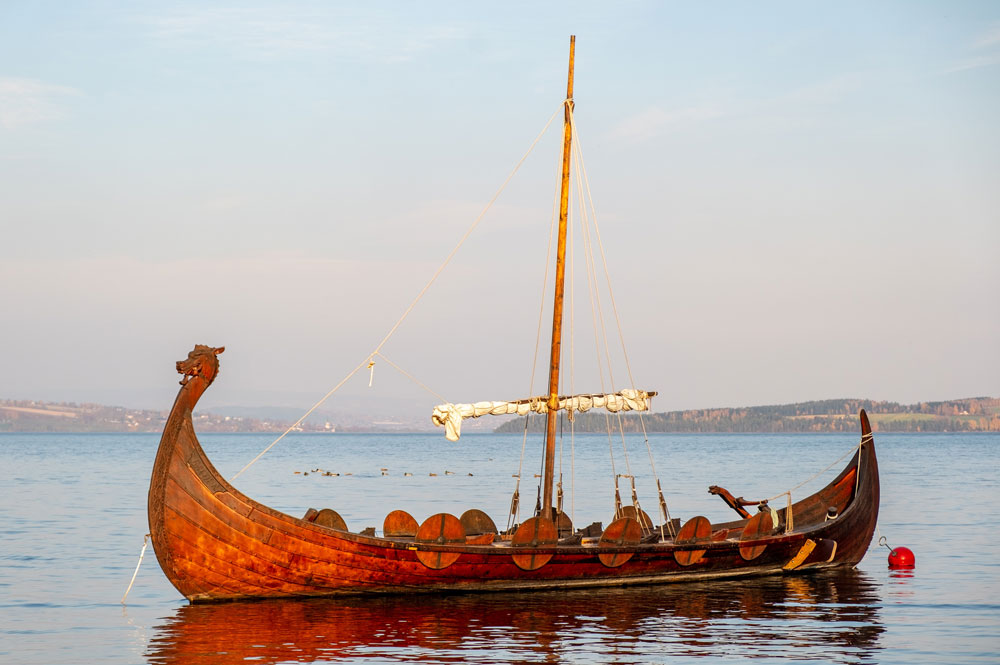
For these creations inspired by Sami culture, we worked with two ancient drum hides, true treasures from Scandinavia. In Sami tradition, the drum is much more than a mere musical instrument. It is a sacred link to the spirits, a guardian of memory, and a representation of the worldview of this northern people. Used by shamans (or noaidi), the drum was employed to enter trance and communicate with the spiritual world, guiding shamans on journeys between different realms: the world of the living, the spirits, and the gods. Adorned with symbolic motifs, these drums guide the shaman in their spiritual journey, allowing them to communicate with the forces of nature and ancestral spirits.
The first drum, named "shaman drum," comes from Lule Lappmark, a region in Sweden. Its hide features the sun, a symbol of life, vital force, and light, accompanied by figures of the deities Ahkka, protectors of the mountains and women, as well as the moon, representing duality, balance, and the transition between the visible and the invisible. In the lower part of the drum, anthropomorphic and theriomorphic figures—part human, part animal—evoke nature spirits and ancestors, whose protection and wisdom were sought by the shaman during rituals.
The second drum, called "Sami drum," is a true work of art depicting a mythical adventure involving the god Thor and the great serpent Eymer. Its hide illustrates three distinct realms: Asgard, the paradise of gods and heroes; Midgard, the land of men; and Niflhel, the realm of the dead, thus highlighting the interconnectedness of worlds in Nordic cosmogony. This epic fresco not only portrays Nordic mythology but also reflects the Sami conception of the universe, where every natural element is endowed with a spirit and partakes in a cosmic balance. These narratives, engraved in the collective memory of Scandinavian peoples, honor their unbreakable connection with their natural and spiritual environment.
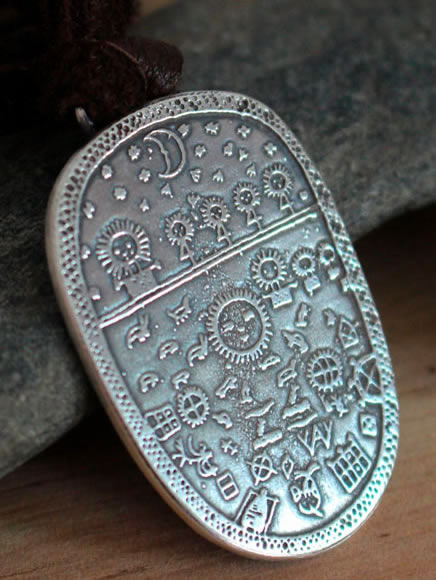
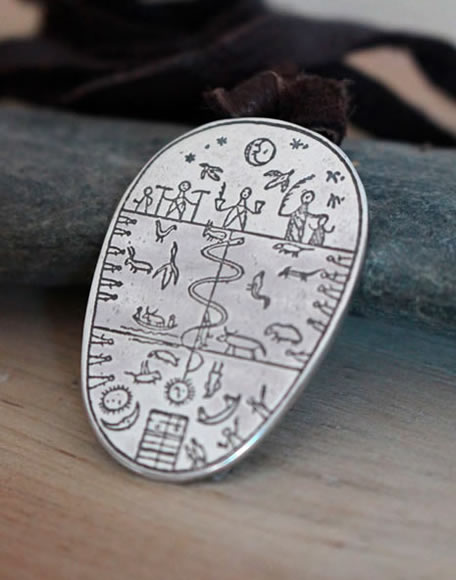
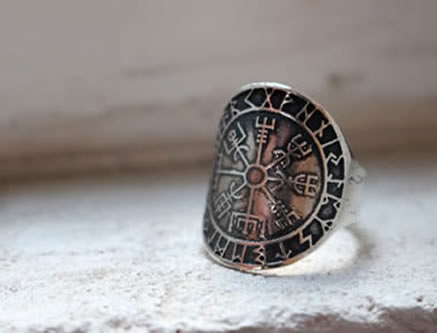
We had the pleasure of exploring Galdrastafir, Icelandic magical symbols of great historical and cultural richness, on two occasions. These symbols, derived from old 17th-century grimoires, likely have roots in much older traditions, dating back to the medieval period or even the Viking era. They are often carved from Nordic runes, rather than Celtic ones as sometimes believed, and are associated with various protective, healing, or magical functions.
The first piece of jewelry, a ring named Vegvisir, features one of the most famous Galdrastafir. This symbol, also known as the "Viking compass," is said to guide its wearer through life’s trials, ensuring a safe and protected journey, even when lost in a storm or facing difficult situations. The Vegvísir is often linked to the idea of finding one’s path, both literally and spiritually.
The second piece, a pendant named Iceland Rune, is a powerful talisman that combines two Galdrastafir, one on each side. On the front, we have the Ægishjálmur, also known as the "Helm of Awe." This symbol is renowned in legends for granting invincibility in battle and protecting its bearer by surrounding them with an aura of strength and intimidation against their enemies. On the reverse side, the Vegvísir reappears, providing protection against the dangers of travel and adverse conditions, a reminder of the close connections the ancient Nordics had with the sea and natural elements.
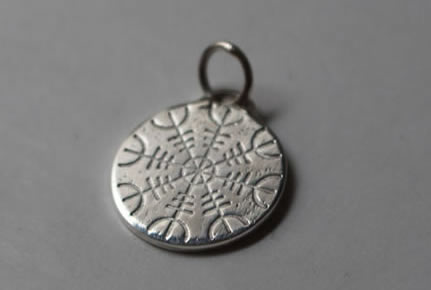
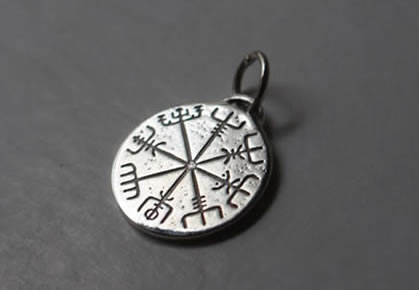
To deepen your knowledge of the art and history of nordic and viking culture, we recommend the following books:
Prehispanic cultures of Mexico jewelry
Mexico and its Pre-Hispanic cultures hold a prominent place in our jewelry collection due to the richness and diversity of the ethnic groups and cultures that populate the country. Our catalog is filled with references to the Aztecs, Olmecs, Maya, Otomi, Huichol, Zapotec, and Mixtec, to name just a few. These ethnic groups have left a cultural and artistic heritage of great value that continues to inspire our work.
The Aztecs, for example, were renowned for their gold and turquoise ornaments, which symbolized both material wealth and spiritual connections with deities. The Maya excelled in carving complex geometric patterns on jade, a sacred material representing life and regeneration. Each civilization had a unique approach to art and jewelry, reflecting their beliefs, history, and techniques.
The Zapotecs and Mixtecs, the last two groups we hold in particularly high regard, are from the state of Oaxaca, where our workshop is also located. These civilizations were especially famous for their goldsmithing skills. The Mixtecs, for instance, mastered the technique of repoussé, creating gold jewelry of unparalleled intricacy, often adorned with mythological motifs. This artisanal expertise, passed down through generations, is a major source of inspiration for us, and we strive to capture that same delicacy and symbolism in our contemporary creations.
Oaxaca, as a region, is also the birthplace of Monte Albán, a major archaeological site of Zapotec culture. This site, with its carvings, stelae, and divine representations, inspires us in creating pieces that honor this heritage. The symbols engraved in stone or the ritual objects discovered on these lands continue to enrich our creative process.
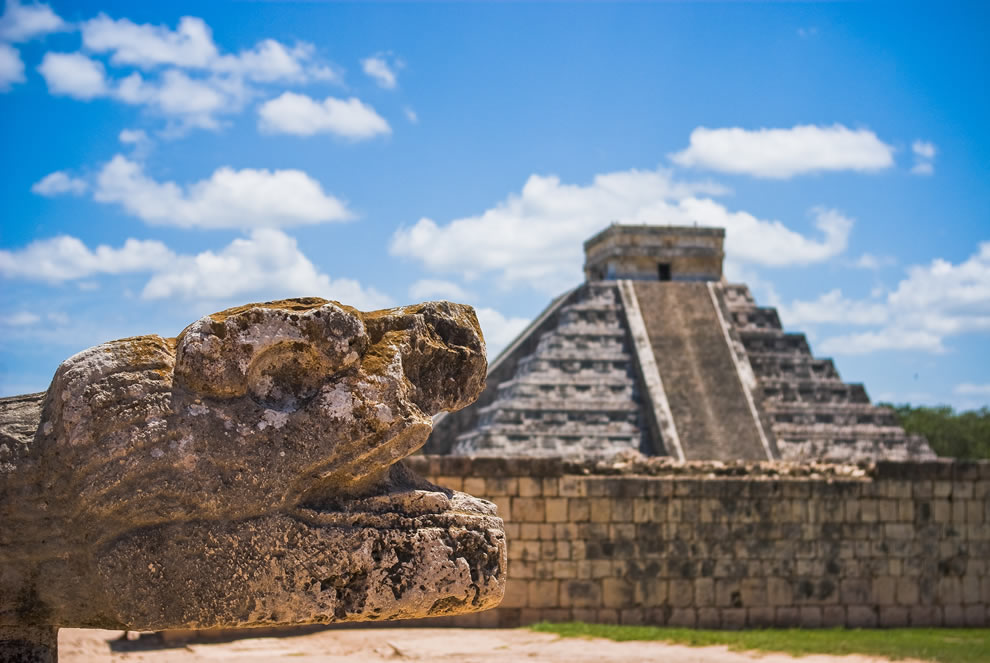
One of the first series of engraved jewelry pieces we created at EmmanuelleGuyon’s workshop is inspired by the Maya calendar. This aesthetically fascinating object is distinguished by the variety of its glyphs, representing each day, month, and year. This technical achievement reflects the precision of the Maya calendar, one of the most sophisticated calendar systems ever developed by humans.
The Maya calendar was not merely a tool for measuring time but played a central role in Maya society. It dictated agricultural cycles, religious ceremonies, and was also used to predict cosmic events. Each cycle held profound spiritual significance, connecting the Maya to their deities and the universe.
To create these jewelry pieces, we had to master the calculation of dates within the Maya system to customize each piece according to the date desired by our clients. The glyphs are not only functional symbols but also tell a visually rich story. Each shape and motif carries meaning: some symbolize deities, elements of nature, or cosmic forces. By engraving these motifs on our jewelry, we aim to capture not only their beauty but also their symbolic depth.
You can find these creations in our store, available as pendants, earrings, brooches, and rings. Each piece embodies a fragment of an ancient civilization, conveyed through timeless symbols. For a more detailed and informative explanation of the Maya calendar, we invite you to visit the following page:
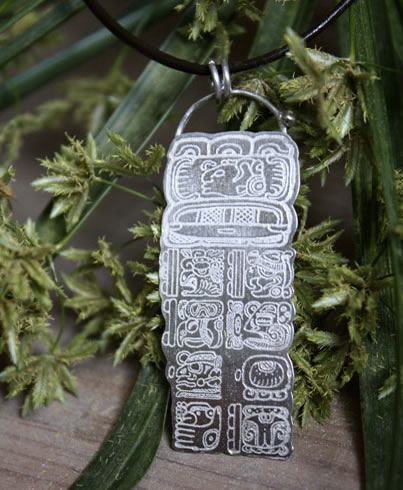
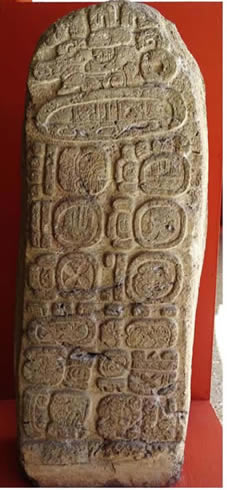
The remarkable work of the "Mexican Greeks," which can be admired at the archaeological site of our neighboring village, Mitla, has profoundly influenced our artistic approach. Mitla, meaning "place of the dead" in Nahuatl, is a sacred site that served as a religious and funerary center for the Mixtec and Zapotec peoples. The intricacy of the mosaics and patterns traced on these works demonstrates exceptional craftsmanship, revealing not only technical skill but also a complex symbolism that remains elusive to researchers.
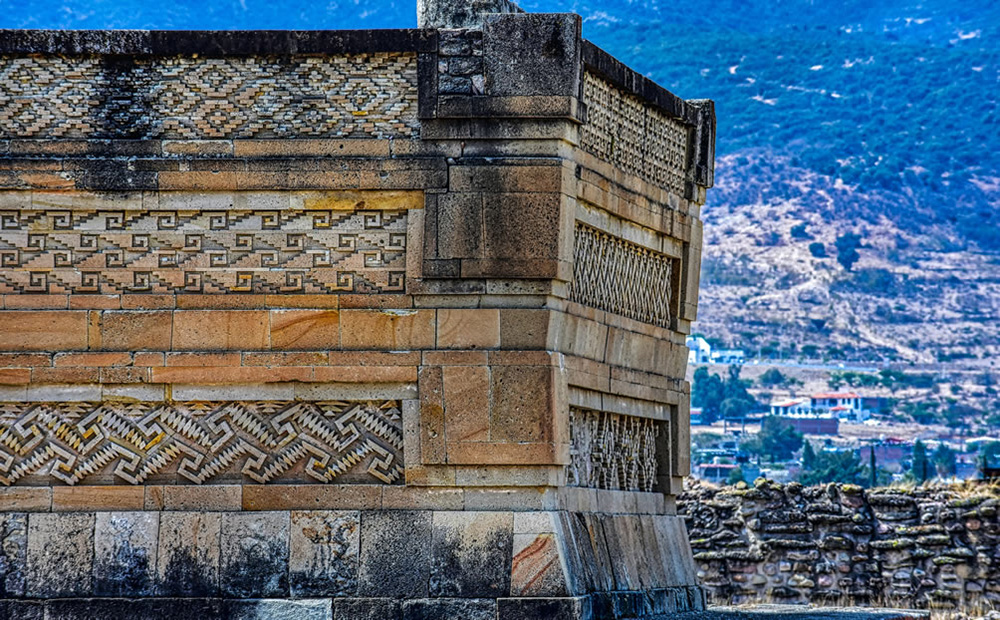
The Greek motifs, found in many Mexican cultures, offer a wealth of variations and regionalisms that transcend national boundaries. These motifs appear in the architecture of several Pre-Hispanic civilizations, including the Zapotecs, Mayans, and Aztecs. Their rigorous geometry and harmonious repetition are often interpreted as abstract representations of cosmic and spiritual concepts. Their context of use is equally diverse: they can be found on temple facades, noble residences, and even in tombs, symbolizing the continuity between the worlds of the living and the dead.
Despite their omnipresence, there is no universally accepted interpretation of these motifs. Depending on the pattern, they may symbolize the cycle of life, water, eyes, serpents, or the sacred diamond. Some scholars view them as representations of the movement of the earth and stars, or as evocations of spirits guiding the souls of the deceased. The mystical depth of these symbols makes their use in jewelry particularly captivating. Each piece we create, inspired by these Greek motifs, carries an intimate connection with this ancient history.
To illustrate these motifs, we drew inspiration from the treasures of Tomb 7 at Monte Albán, a major archaeological site in Oaxaca, which was the capital of the Zapotec empire until around 800 AD. This site, perched on a hill, demonstrates the architectural ingenuity and cultural significance of this civilization. Several centuries after its abandonment, the Mixtec people buried an important figure there, potentially a female associated with the water cult, as suggested by the funerary objects. This figure was accompanied by the largest treasure ever discovered in Mexico, including numerous gold, jade, turquoise, and shell jewelry pieces, now displayed at the Regional Museum of Oaxaca. Among these treasures are a series of rings that inspired some of our creations.
We designed a ring named "Tesoro zapoteco," paying tribute to the fabulous treasure of Monte Albán. Engraved in silver, this ring features a geometric Zapotec design, both captivating and enigmatic in its deep symbolism. Spirals, a recurring motif in Zapotec art, are often interpreted as representations of the movement of water, essential to life. Staircase representations symbolize the cycle of life and progress toward a higher spiritual plane. This motif is traditionally associated with the image of the serpent, a primordial figure of water and fertility in Zapotec culture.
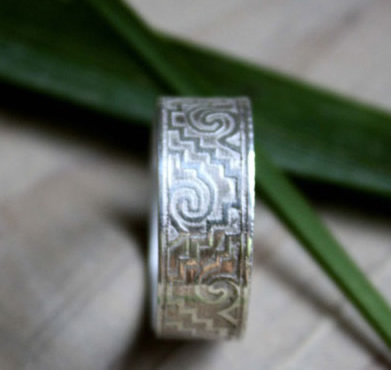
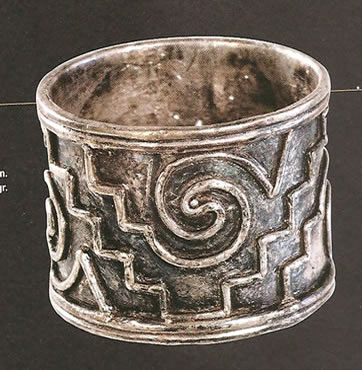
The second ring, inspired by the treasure of Tomb 7, is known as "serpiente de agua" or "water serpent." This motif is also found on the facades of palaces in Teotitlán del Valle and in tombs at Yagul, another significant archaeological site in Oaxaca. It is often compared to eyes formed by the body of a serpent, symbolizing water and the rain god, Cocijo. In Mesoamerican tradition, Cocijo is equivalent to Tlaloc among the Aztecs and Chaac among the Mayans, representing not only agricultural fertility but also the destructive power of storms. This motif, rich in meanings, embodies fertility, regeneration, and the eternal cycle of life and death.
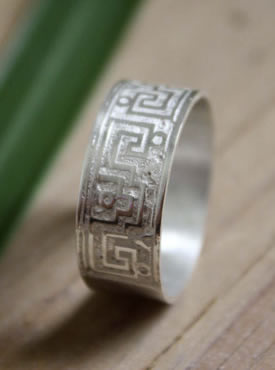
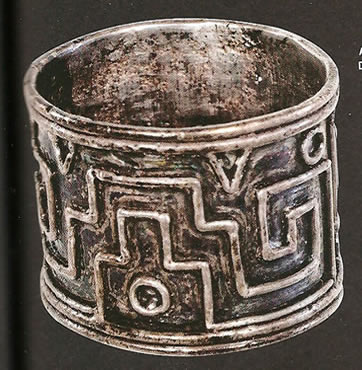
Finally, the third ring in this collection, named "Ga Yixe," takes its name from the goddess "9 herbs," a divine feminine figure associated with fertility and the cycles of nature. The priestesses connected to this cult might have been buried in Tomb 7, given the agricultural and fertility-related ritual objects discovered there. We chose to recreate the ring in a more streamlined version while respecting the original design in gold and silver, to pay homage to the timeless elegance of these ancient jewels.
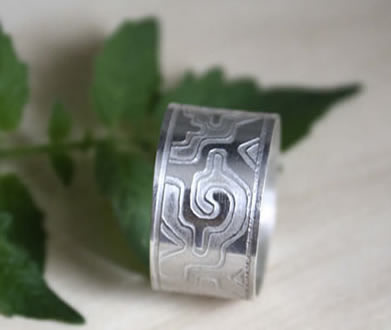
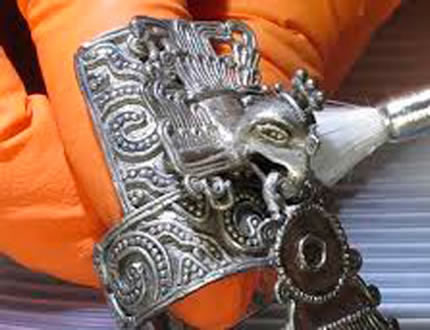
We have also designed a series of Mexican pendants inspired by the glyphs and Pre-Hispanic symbols found in stone inscriptions and codices. Each piece is an artistic and symbolic representation of the heritage of this ancient culture, providing wearers with a tangible connection to the past.
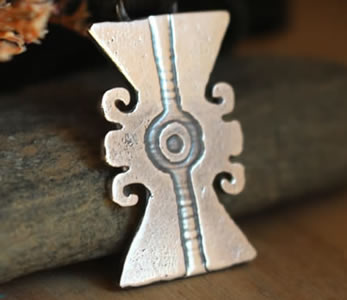
Among these creations, we have developed two distinct pendants based on the Ollin motif, or "movement," a central symbol in Aztec writing and Mesoamerican cosmology. This symbol is rich in meaning, evoking both the constant movement of the universe and the natural cycles that govern the cosmos.
The first pendant, simply named Ollin, represents movement and shaking. It is often associated with the dynamic forces of the Earth, such as earthquakes, and symbolizes perpetual change and evolution. For the Aztecs, this motif embodies transformation and journey, both in physical and spiritual realms. Wearing this pendant reflects the idea that everything is in motion and transformation in the universe.
The second pendant, named Nahui Ollin, carries a more complex significance. This symbol represents the four movements of the sun between the solstices and equinoxes, marking the cycles of sacred time and the importance of cosmic harmony. In Aztec cosmology, Nahui Ollin is also linked to the Fifth Sun, the era in which the Aztecs believed they were living. This Sun was destined to end in earthquakes, reminding us that the balance of the world is fragile and in constant renewal. This motif is drawn from the famous Codex Borbonicus, one of the most important Aztec codices, which provides crucial information on Aztec cosmology, religion, and ritual calendar.
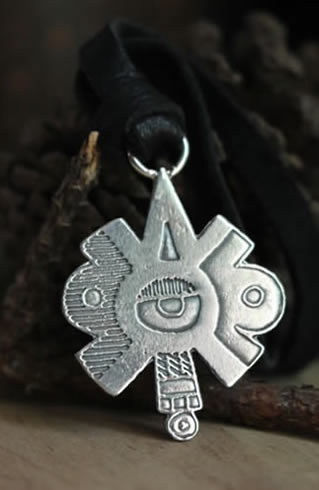
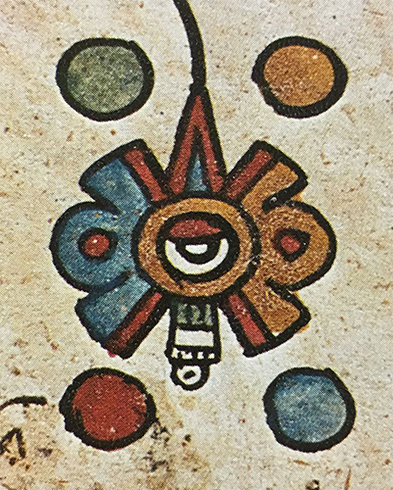
Another glyph we have incorporated is that of the rabbit on the moon, drawn from the famous Codex Borgia, a Mesoamerican manuscript dating back to the 16th century. This fascinating symbol is closely associated with the moon goddess, Metztli, who oversees the lunar cycles and the forces of darkness. In Aztec cosmology, the moon plays a fundamental role as the counterpart to the sun, and the image of the rabbit etched on its surface is linked to ancient legends describing how it was projected onto the moon.
According to one legend, the god Quetzalcoatl, traveling in human form, encountered a humble rabbit when he was exhausted and starving. Moved by compassion, the rabbit offered him food. Touched by this gesture, Quetzalcoatl projected the image of the rabbit onto the moon as a token of gratitude, making it immortal in the night sky. This story illustrates both the importance of acts of generosity in Mesoamerican tradition and the rabbit’s recurring role as a lunar symbol.
But it is not only in Mexico that we find stories linking a rabbit to the moon. This motif is also present in other cultures, such as in East Asia, where the rabbit is often depicted preparing an elixir of immortality on the moon. This figure appears in Chinese and Japanese traditions, demonstrating the universality of this symbol. The presence of the rabbit on the moon across various civilizations reveals a deep connection between humans, the cosmos, and the mythological narratives that traverse time and space.
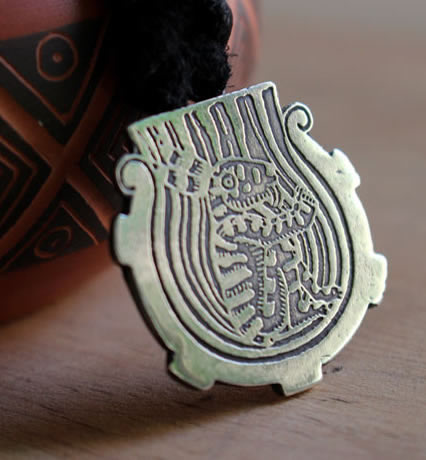
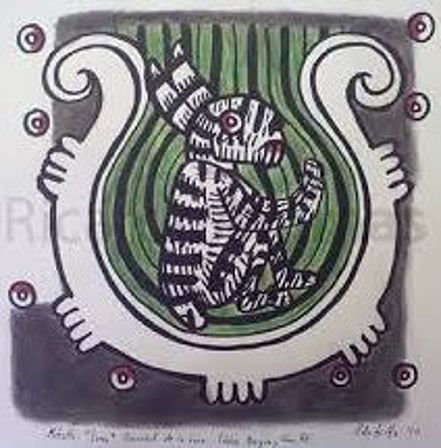
We have also selected two representations of hands from the Olmec civilization, often considered the "mother culture" of Mexico, which influenced many other Mesoamerican cultures. This civilization, which thrived between 2500 BCE and 500 BCE, was the source of numerous artistic and spiritual developments. The two pendants, derived from Olmec seals, are named "Olmec hand" and "Creator power." In Pre-Hispanic cultures, the hand is not merely a physical tool but symbolizes creative and divine power, the force that transforms and shapes the world.
In Olmec art, the hand is frequently associated with creative acts and symbols of fertility. This representation establishes a direct connection with the earth and natural elements. The hand motif, engraved in our pendants, evokes skill, and the ability to shape the environment, much like the gods and ancestors revered in Olmec culture.
This symbolism of the hand transcends Mesoamerican boundaries. It appears in many cultures around the world, where it embodies creation, power, and mastery of art. Whether in ancient Egypt, where the hand was linked to the god Ptah, creator of the universe, or in Asian traditions where mudras (sacred gestures) are used to channel spiritual energy, the hand holds a central place in humanity’s symbolic imagination.
The "Olmec Hand" and "Creative Power" pendants we have designed pay tribute to this powerful symbolism. They capture both the ancient tradition and contemporary craftsmanship, offering the wearer an intimate connection with the past and the creative strength that the hand represents.
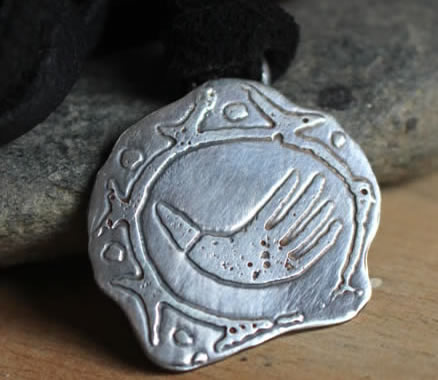
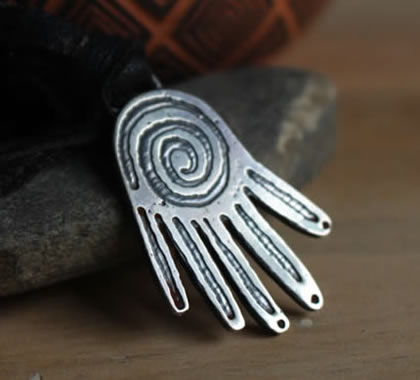
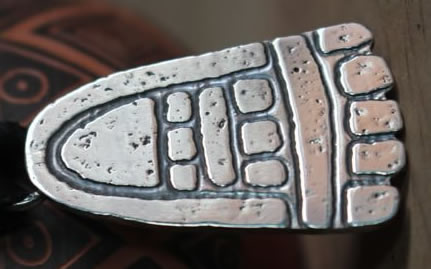
In the same spirit, we have designed a pendant inspired by an Olmec stamp, depicting a foot. This motif evokes movement, symbolizing the transition from one point to another. We named it "Movement," as it portrays one foot interlocked with another, suggesting the idea of successive steps. This pendant embodies the dynamic energy of movement, symbolizing vitality and the constant progression in life.
In Olmec cosmology, movement held significant importance, tied to their understanding of time, space, and natural cycles. The foot, a symbol of progress and connection to the earth, reflected this concept of continuous transformation, where each step represents a new stage in the journey of existence. Movement was not only physical but also spiritual, marking the soul’s path through the various dimensions of life.
This interlocked foot symbol can also be interpreted in a broader context, as in many cultures around the world, the foot is often associated with transition, walking into the unknown, or an intimate connection with nature. It represents grounding in the present while opening the way to the future. This universal symbolism further enriches the meaning of the "Movement" pendant, echoing rites of passage and perpetual evolution.
We also selected a glyph for the "Eclipse" pendant. This motif comes from the Codex Borbonicus, a highly significant Aztec document. The glyph, divided into two parts, depicts in the upper section a radiant sun, symbolizing life, warmth, and light. In the lower section, the night is represented, dotted with stars, symbolizing darkness, rest, and mystery. This glyph can be interpreted as an eclipse, a cosmic event both fascinating and feared in many cultures, but it also evokes the perpetual cycle of day and night.
The interpretation of this glyph in the Aztec context reinforces the idea of duality inherent in their worldview: light and darkness, life and death, movement and stillness. These complementary oppositions are at the heart of their cosmology, where day and night, represented by the sun and the moon, are inseparable. The "Eclipse" pendant pays tribute to this interconnection, emphasizing the necessary balance between these opposing forces that govern the universe.
In Aztec tradition, an eclipse was not merely an astronomical event but a sign from the gods, bearing omens and spiritual influences. Eclipses were often linked to rituals aimed at appeasing the deities, and this pendant can also symbolize that sacred connection between the human world and the cosmos.
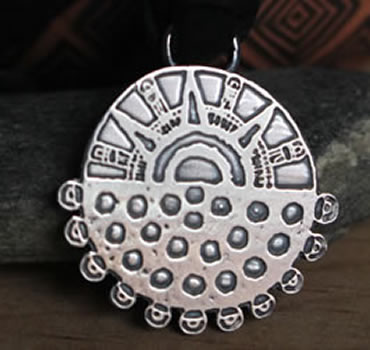
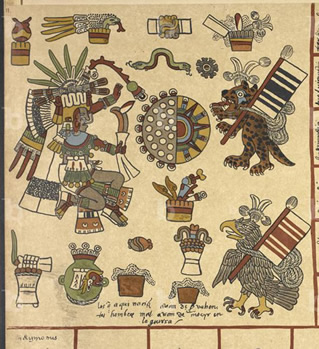
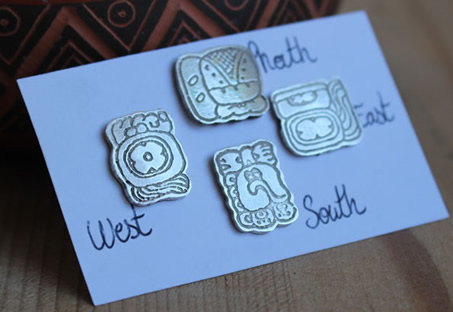
We decided to create earrings by combining different symbolic glyphs important to the Maya. We began with the set named "Mayan cardinal points," composed of four pieces representing the glyphs of the four cardinal directions: East (Lak’in), West (Chik’in), South (Nojol), and North (Xaman). These glyphs hold great significance in the Mayan culture of Mexico, as they are closely tied to the concept of the cycle and the path of the sun, the primary god of their pantheon, to whom life and the universe are intrinsically connected.
In Mayan cosmovision, these four directions are not merely geographical points but pillars of cosmic order. Each cardinal direction is associated with a specific color and divine energy. For example, the East is traditionally linked to the color red, representing birth, dawn, and the energy of renewal, while the West, associated with black, symbolizes the end of the cycle, dusk, and the spirit world. The South is connected to the color yellow, embodying maturity and prosperity, while the North, tied to white, represents ancestral wisdom and the resting place of souls.
These four directions also play a crucial role in Mayan rituals, where they are often invoked to balance and harmonize energies during ceremonies, particularly those related to agriculture and natural cycles. Thus, the "Mayan Cardinal Points" earrings are not merely decorative pieces but powerful symbols, connecting the wearer to the cosmic order and the eternal cycle of life.
We also created a pendant replica of an Aztec stone drum, which we named Xochipilli, after the god of music, love, games, beauty, dance, flowers, and poetry, who is depicted on it. This ritual instrument, called a Teponaztli or horizontal drum, was used in ceremonies to accompany dances and songs dedicated to the deities.
The Teponaztli held a central place in Aztec religious rituals. Its sacred sound, resonating through the temples, served to strengthen communication with the gods, fostering a profound spiritual connection. During ceremonies, the rhythm of this drum accompanied the graceful movements of the dancers and the melodies of the songs dedicated to Xochipilli and other deities, creating harmony between humans and the divine.
In addition to being the god of music and the arts, Xochipilli is also associated with divine ecstasy and transcendental joy. The pendant we designed captures this spiritual dimension, evoking the state of rapture and beauty sought during religious rituals. By wearing this pendant, one connects not only to the history of the Aztecs but also to the spirit of celebrating life, love, and art in its purest form.
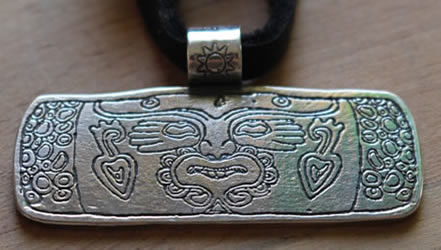
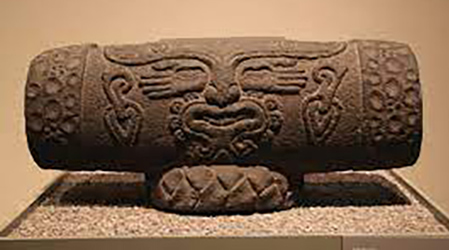
For one of our clients, we designed a pendant representing Kukulkan, one of the major gods of the Mayan pantheon, also known as the Feathered Serpent. Kukulkan embodies the power of the four elements — air, earth, water, and fire — and serves as the creator of the universe. A symbol of resurrection and reincarnation, he is closely linked to the cycle of life, death, and rebirth. In Mayan civilization, Kukulkan was also the protector of maize, the vital element at the heart of their agriculture and spiritual culture.
We drew inspiration from Lintel 15 of Structure 22 at the archaeological site of Yaxchilan to represent this god. In this carving, Wak Tuun, the wife of King Bird Jaguar IV, is depicted in a sacred ritual offering her blood to receive a vision of the Vision Serpent, Kukulkan. This blood sacrifice ritual aimed to contact divine spirits and ensure balance between the spiritual and material worlds. Kukulkan, appearing as a winged serpent, acts as a guide between these worlds, symbolizing both wisdom and regeneration.
At the client’s request, we added a turquoise stone to the pendant. In Mesoamerican cultures, turquoise is closely associated with the element of water, essential for the survival of civilizations. A symbol of purity and protection, the stone also evokes the spirit of rain and rivers, further emphasizing the importance of the natural cycle of fertility and abundance, which were fundamental principles for the Maya. This choice highlights the duality between water and maize, perfectly linking nature and the divine in harmonious balance.
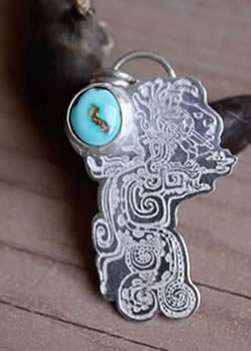
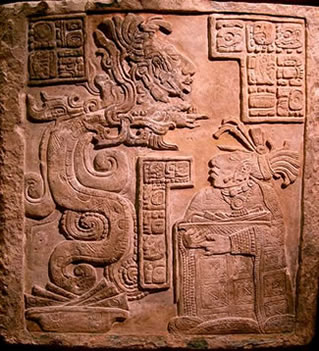
In the same vein, we designed another pendant on the theme of the Feathered Serpent, simply titled "Feathered snake," this time inspired by Aztec culture. This pendant represents the god Quetzalcóatl, a central figure in the Aztec pantheon, symbolizing wisdom, wind, and life. The representation we chose comes from a *tepetlacalli*, a ceremonial stone chest from the Hackmack collection. This type of chest, with its lid engraved with the image of Quetzalcóatl, dates back to the period between 1502 and 1520 A.D., just before the fall of the Aztec empire.
*Tepetlacalli* were often used to store sacred objects, ritual offerings, or even the ashes of deceased rulers. The choice of Quetzalcóatl on this particular piece highlights the spiritual and political significance of this god for the Aztec elites. As a deity associated with the creation of the world and the connection between humans and the divine, Quetzalcóatl symbolizes the cycle of life, death, and rebirth.
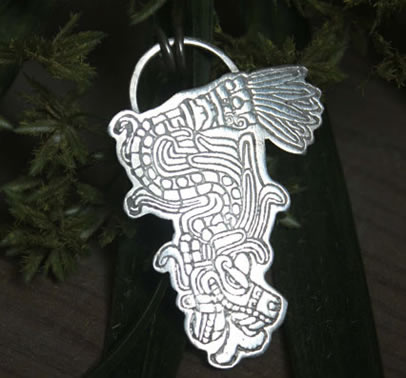
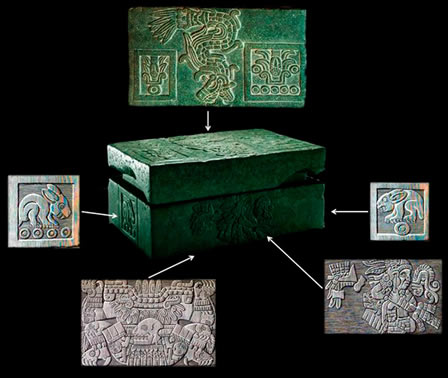
The pendant named "Quiquiztil" is a creation inspired by a sculpted musical conch shell, representing the head of a Maya ruler from the Classic period (250-400 AD). This conch, likely originating from northeastern Guatemala and now housed at the Kimbell Art Museum in Texas, is a rare piece that illustrates the importance of music and ritual in Maya culture. Used in rituals by priests to call for rain and to celebrate military victories, it resonated with solemn power, marking ceremonies with its mystical echo in the sacred landscapes of the time.
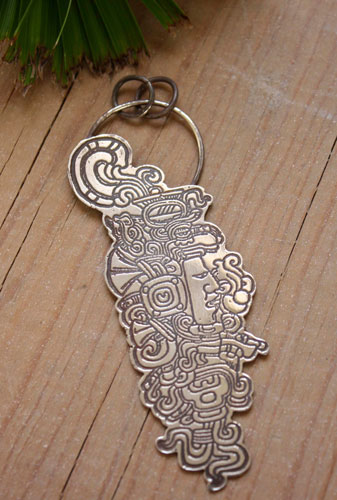
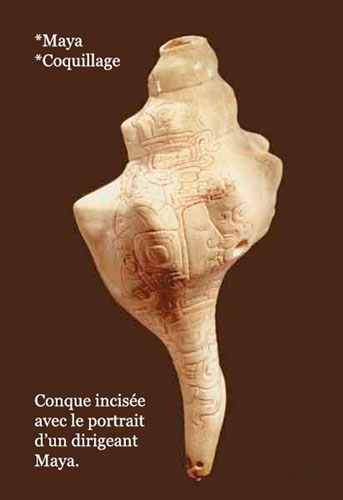
The pendant we named "Mesoamerica" is a custom piece, created in response to the specific desires of our client. While this motif is often featured in jewelry inspired by Mesoamerican culture, we added personalized glyphs on the back to give it a unique touch.
The main design of this pendant is inspired by the central portion of the Aztec Sun Stone, also known as the Aztec Calendar. This monumental stone, housed at the National Museum of Anthropology in Mexico City, dates back to 1479 and likely served as a *Cuauhxicalli*, a receptacle and altar for sacrifice. For our interpretation, we chose to depict only the innermost circles of the calendar.
The first circle features a hybrid head combining the sun god Tonatiuh and the earth goddess Tlaltecuhtli, symbolizing the union of sky and earth. The second circle displays symbols representing the gods Ehecatl, Texcatlipoca, Tlaloc, and Chalchiuhtlicue, echoing the legend of the Four Suns, an Aztec cosmogony describing the stages of world creation. Lastly, the outer circle of the pendant shows the 20 day glyphs of the month, offering a complete view of the calendrical system and the concept of time in Mesoamerican tradition.

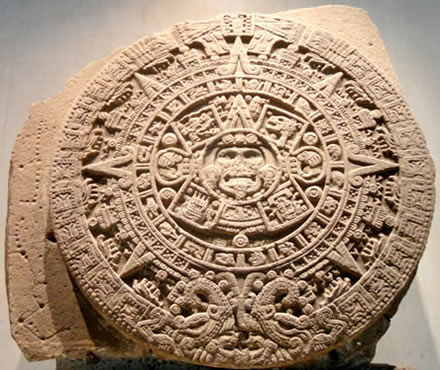
To deepen your knowledge of the art and history of mexican culture, we recommend the following books:
Antique Egypt jewelry
Egypt, much like ancient Greece, is one of the earliest civilizations that continues to captivate history and archaeology enthusiasts for a variety of reasons. Its majestic structures, such as the Pyramids of Giza, built as tombs for the pharaohs, and the temples of Karnak, stand as testaments to its rich architectural heritage and advanced engineering.
The pharaohs, divine rulers of Egypt, left a significant mark on the country’s history through their absolute power, influence on religion, and their cult of the afterlife, symbolized by the lavish tombs in the Valley of the Kings. These tombs were adorned with treasures and artifacts meant to accompany the deceased into the afterlife, reflecting the Egyptian belief in life beyond death.
Egyptian mythology, with its gods and goddesses such as Ra, Osiris, Isis, and Horus, inspired epic tales and deeply rooted beliefs within Egyptian society. Funeral rites, including mummification and elaborate burial rituals, persisted for millennia, highlighting the complexity of religious practices and the quest for immortality.
In sum, ancient Egypt is a true treasure trove of knowledge and discovery for anyone interested in the history of humanity, offering a fascinating glimpse into the culture, beliefs, and practices that shaped one of the most iconic civilizations in history.
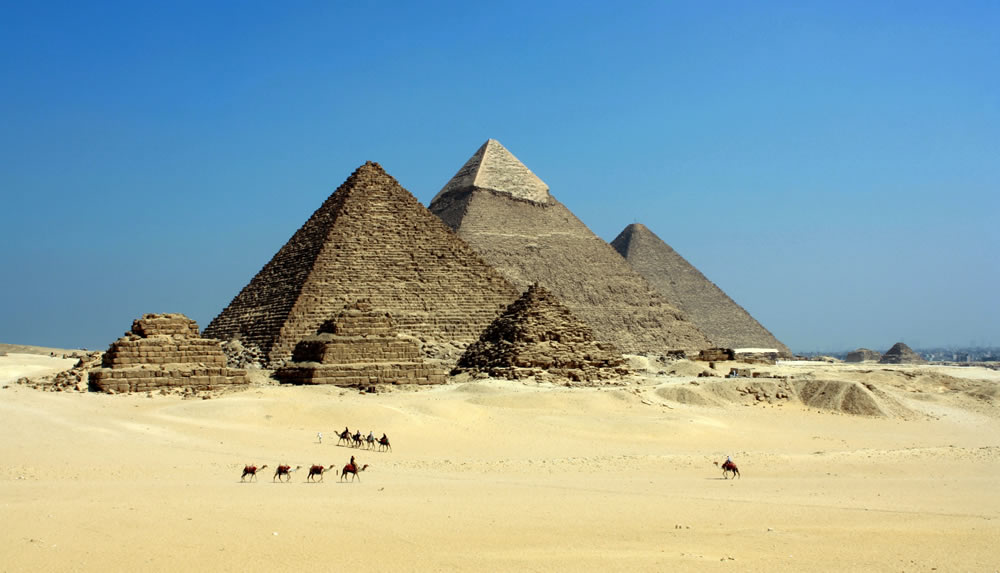
Recently, we had the privilege of discovering a silver jewel of rare singularity, yet little known to the general public: the Hypocephalus. This Egyptian disc, of profound beauty and significance, was carefully placed beneath the heads of mummies, not only to ease their passage into eternity but also to protect them from the demons of the underworld. According to Egyptian belief, once the deceased reached this state, they attained a form of transcendence, becoming a "glorious" being, reflecting the image of the god Ra-Osiris, symbolizing eternal life and rebirth.
This particular necklace, known as the Hypocephalus of Harnetatf, is an exceptionally rare and beautiful piece. The original is currently on display at the British Museum, where it captivates visitors with its rich history and profound symbolism. It is said to have belonged to the priest Hornedjitef, who served at the temple of Amun at Karnak between 246 and 222 BC, a period of great splendor for ancient Egypt.
In the upper section of this object, one can admire the boat of the god Kneph, also known as Chuouphis, a major deity in Egyptian mythology and a form of Osiris, the god of death and rebirth. The carefully engraved four-headed ram holds immense symbolic significance. This ram, a symbol of power and fertility, is often associated with the city of Mendes or the god Amun-Ra, the revered solar deity of ancient Egypt. The figure is depicted being worshiped by baboons, sacred animals in Egyptian religion, representing wisdom and knowledge.
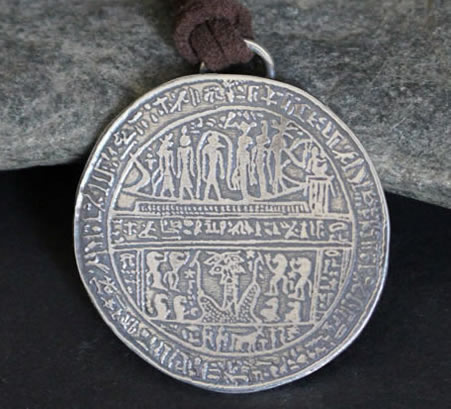
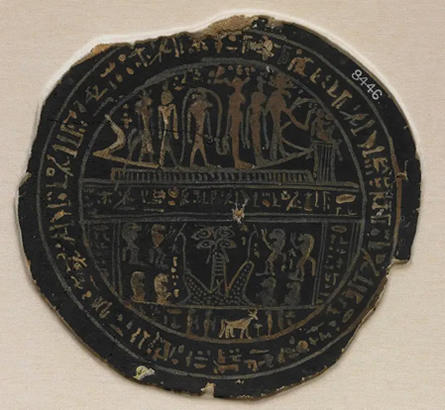
We have created a second necklace inspired by an Egyptian hypocephalus, known as the Hypocephalus of Djed-Hor. This piece showcases an even greater richness of hieroglyphs compared to our first creation. The Hypocephalus of Djed-Hor was discovered in the sacred city of Abydos, a site closely associated with the worship of Osiris, the god of death and resurrection. This piece dates from between 380 and 332 BC and belonged to the priest Djed-Hor. It is now housed at the Museum of Fine Arts in Boston, where it continues to captivate visitors with its artistic beauty and profound symbolism.
The inscription surrounding the motifs of this hypocephalus comes from Spell 162 of the Book of the Dead, a fundamental text in Egyptian religion. This spell, also known as the "Spell of the Heat of Life," was intended to bestow upon the deceased the necessary energy for their resurrection, ensuring their rebirth in the afterlife. This text reflects the central Egyptian belief in the continuation of life after death, where the body needed to be revitalized to navigate the underworld and join the realm of the gods.
This necklace also highlights major symbols such as the four-headed ram, a complex figure often associated with Amon-Ra, the solar deity and creator, as well as the city of Mendes, where the ram represented power and fertility. Carefully engraved, this ram is accompanied by baboons, sacred animals in Egyptian tradition. In this context, the baboons symbolize wisdom, knowledge, and spiritual connection, often associated with the god Thoth, the master of writings and mysteries.
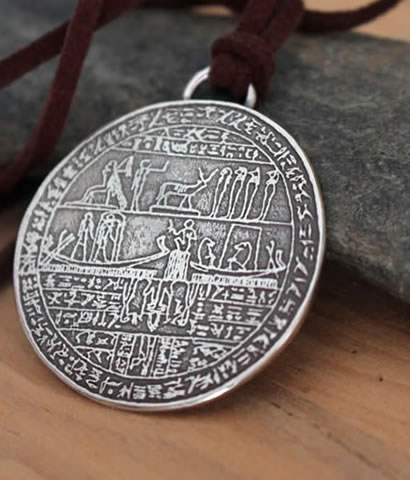
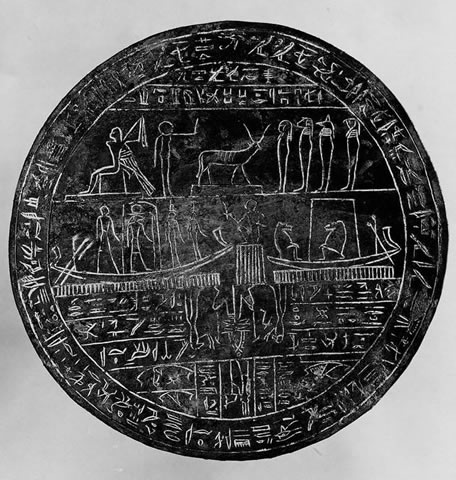
To deepen your knowledge of the art and history of antique Egypt, we recommend the following books:
Mesopotamian jewelry
Mesopotamia, often referred to as the "cradle of civilization," experienced remarkable growth during the Neolithic period, marking the beginnings of agriculture and human settlement. This region, situated between the Tigris and Euphrates rivers, witnessed the rise of flourishing cities, sophisticated irrigation systems, and technological advancements that profoundly influenced the development of human civilization.
Yet, despite its historical significance and impact on our modern world, Mesopotamian culture remains largely unknown to the general public. Its contributions to architecture, writing, religion, science, and many other fields are crucial for understanding the evolution of human society.
Mesopotamia, with its city-states such as Ur, Uruk, and Babylon, its epic legends like the Epic of Gilgamesh, and its deities like Marduk and Ishtar, continues to captivate historians, archaeologists, and enthusiasts of ancient history. Its legacy, though sometimes overlooked, is undeniably one of the richest and most influential in the history of humanity.
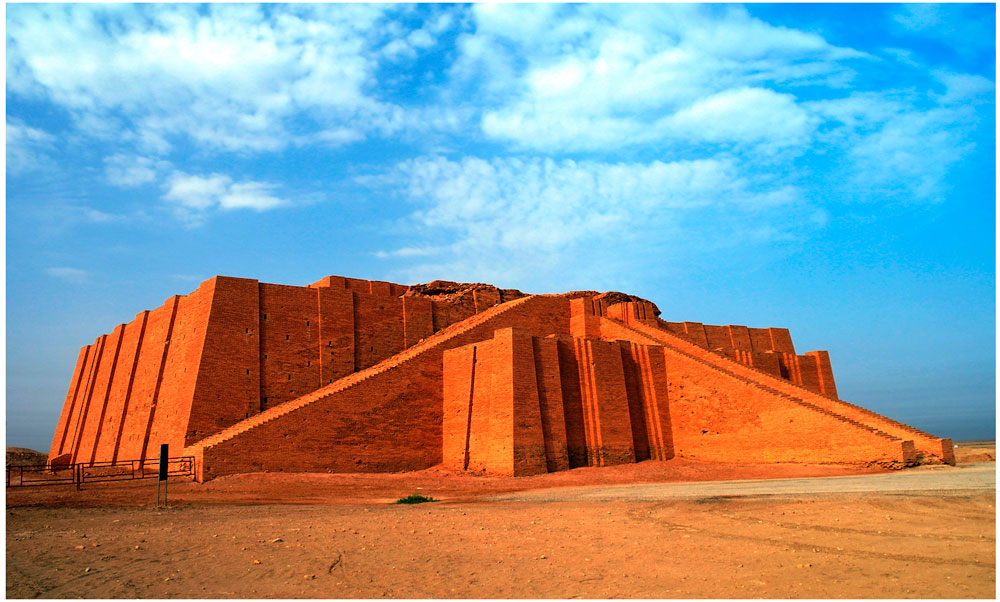
Recently, we delved into the study of early writing systems, focusing particularly on the Epic of Gilgamesh, one of humanity’s foundational texts. This captivating narrative, considered one of the oldest literary works, transports us to a world where gods and humans coexist, where heroes face monumental trials, and where the quest for immortality becomes the center of existential reflections.
Our creation, the Gilgamesh necklace, is directly inspired by the famous cuneiform tablets. We chose to represent an authentic fragment from a tablet discovered during the excavations at Kouyunjik in Iraq, a site that once housed the library of Ashurbanipal, the last great king of Assyria. This fragment, dating from between 950 and 612 BCE, preserves a valuable portion of Gilgamesh’s adventures, contributing to the transmission of this narrative through the ages.
The Gilgamesh necklace, with its meticulously engraved cuneiform characters, pays tribute to the ancient Mesopotamian scribes, the custodians of knowledge and culture. These inscriptions not only reflect their technical skill but also highlight the significance that Mesopotamian civilization placed on preserving its stories and heritage.
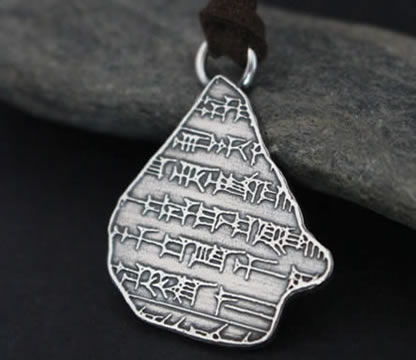
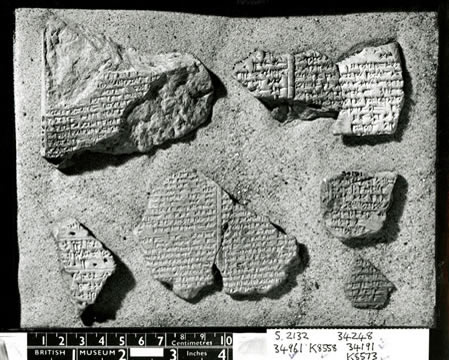
The necklace inspired by The cylinder seal of the king of Kisch is a remarkable example of the impact left by this essential tool of Mesopotamian culture. The cylinder seal played a crucial symbolic and administrative role. Used to seal and authenticate documents and valuable objects, it testified to the power and authority of its owner. Cylinder seals were often worn by kings, dignitaries, and high officials, reflecting their elevated social status.
The cylinder seal we have recreated depicts a major episode from the Epic of Gilgamesh. The engraved scene shows the hero-king Gilgamesh, accompanied by mythical bulls, standing proudly between two lions. This powerful image symbolizes both the bravery, strength, and sovereignty of Gilgamesh. Lions, recurrent figures in Mesopotamian art, were associated with royalty and divine protection, while mythical bulls symbolized abundance and fertility.
This fascinating artifact is currently housed at the University of Pennsylvania Museum of Archaeology and Anthropology, where it continues to captivate visitors with its finely crafted engraving and deep symbolism. Discovered in the tomb of Mesannepada, the first king of the First Dynasty of Ur, this seal cylinder, dating from the 26th century BCE, reflects the splendor and complexity of Mesopotamian civilization.
By choosing to reproduce this cylinder seal fragment in jewelry, we aimed to capture not only the artistic beauty of the original but also the legacy of an era where power, the divine, and administration were intimately intertwined. This necklace is both a celebration of heroic bravery and a testament to the rich cultural heritage of Mesopotamia.
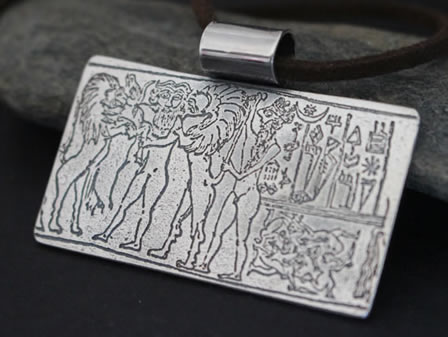
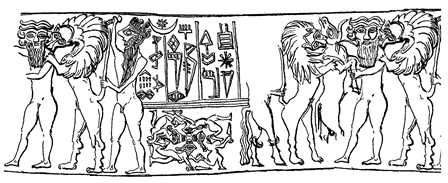
To deepen your knowledge of the art and history of Mesopotamia, we recommend the following books:
European Neolithic jewelry in the age of bronze and iron, Celts and druids
The Neolithic period, often referred to as the "Agricultural Revolution," marks a crucial chapter in human history. It is during this time that humans began to domesticate plants and animals, leading to the development of agriculture and animal husbandry. This shift gradually transformed nomadic groups into settled communities. This new way of life also brought about a major discovery: the mastery of metals. Initially, people worked with stone, bone, and wood, but with the transition to the Bronze Age, they began to explore metals such as copper and tin, creating increasingly sophisticated tools and ornaments.
Megalithic monuments such as cromlechs, dolmens, and menhirs began to appear throughout Europe. These monumental structures, often used for ritualistic or funerary purposes, reflect the importance placed on seasonal cycles and the relationship with the cosmos. Menhirs, in particular, symbolize a direct connection between humans and cosmic forces. Their alignments, often associated with astronomical events like solstices, demonstrate an advanced understanding of natural cycles.
With the advent of the Iron Age, the Celts came to dominate much of Europe, and their culture flourished. Celtic jewelry, crafted from bronze, gold, and sometimes iron, is decorated with geometric patterns or spirals that embody spiritual concepts such as eternity, renewal, and the connection between the physical and spiritual worlds. These motifs often have their origins in druidic beliefs, where nature and its cycles were central to rituals and celebrations. For example, Celtic spirals symbolize the journey of the soul through life, death, and rebirth.
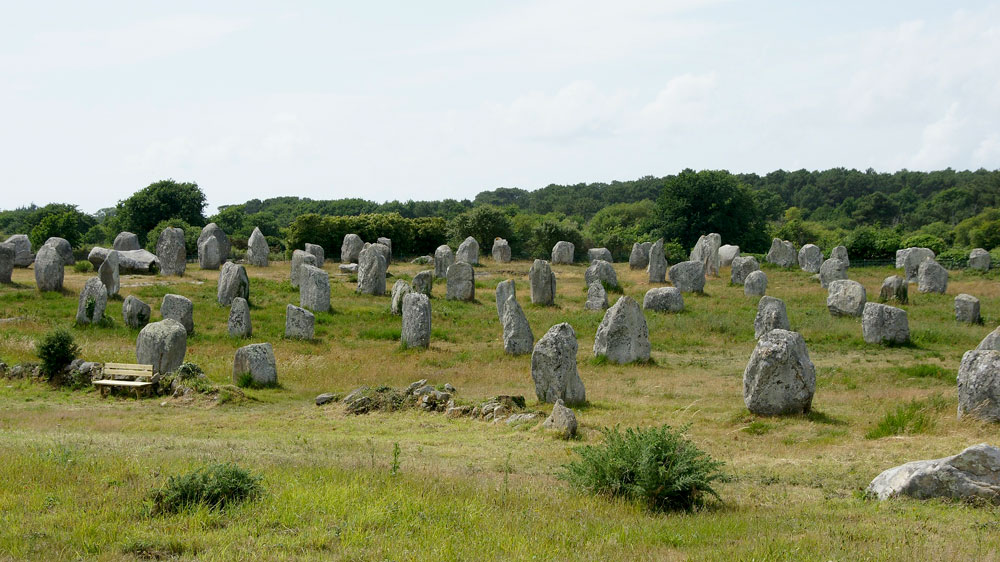
The relationship between humans and nature is a theme that holds particular significance for us, as reflected in our page dedicated to "Druids and Druidesses: Communication with Nature." Druids, central figures in Iron Age Celtic societies, were both wise individuals, healers, and spiritual guides. They possessed profound knowledge of plants, animals, and natural cycles, using this knowledge to guide their communities towards a lifestyle in harmony with the environment. Their ritual practices, often conducted in sacred forests or near water sources, reflected a deep reverence for nature as a source of wisdom and spiritual power.
In our catalog, we offer a selection of archaeological reproductions that testify to this profound relationship between humans and nature. Among them, we have recently added two engraved stelae, discovered in cairns, as well as a menhir. These artifacts serve as witnesses to how our ancestors sought to express their connection with the spiritual and natural world through symbolic engravings. Cairns, stone mounds, often served as burial sites but also as territorial markers, reminding us of humanity’s enduring presence in sacred landscapes.
We hope these reproductions will help you better understand and appreciate the richness of the relationship between humans and nature, and inspire you to preserve this precious connection for future generations.
The guardian stone of Newgrange is an Irish archaeological treasure dating from around 3200 BC, which inspired the creation of a unique pendant. Positioned horizontally at the entrance of the Newgrange cairn, a megalithic tumulus located in the Boyne Valley, this massive stone has been dubbed the "Guardian Stone" due to its symbolic protective role. The cairn itself is a remarkable funerary and astronomical monument, aligned with the sunrise on the winter solstice, reflecting the sophisticated understanding of celestial cycles by Neolithic peoples.
The spiral motifs adorning the stone are characteristic of megalithic art and have fascinated archaeologists for centuries. These spirals, often arranged in triples or doubles, remain mysterious in their exact meaning. Some interpretations link them to natural elements such as water, wind, or serpents, symbolizing the flow of vital forces in nature. Other theories suggest they may represent topographical maps, with spirals symbolizing hills, paths, or valleys, marking sacred sites or ancestral routes.
In addition to the complexity of these carvings, it is the strategic position of this stone that gives it its guardian status. Placed at the entrance of the cairn, it appears to have been designed to protect access to the funerary and ritual secrets hidden within the monument. This idea of protection particularly inspired us in creating this pendant, which symbolizes not only physical protection but also the preservation of our ancestors' memory. By transforming this stone into a piece of jewelry, we aim to honor the connection between humans, nature, and the cosmos, perpetuating the mysteries of the past.
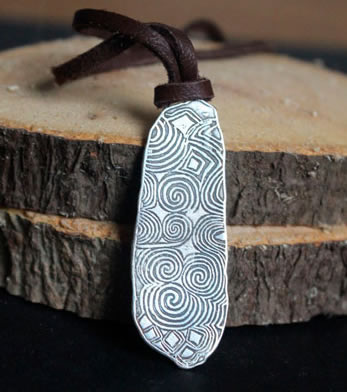
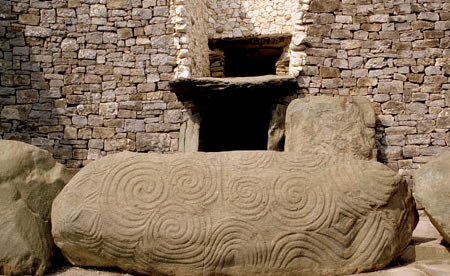
The second pendant we created is inspired by the Cairn of Gavrinis, located in the Gulf of Morbihan, Brittany, France. Erected on a small island about 6000 years ago (4000 BC), this cairn is one of the oldest and most remarkable megalithic monuments in Europe. The long funerary corridor of Gavrinis is adorned with carved stones, and it is one of these orthostats—standing stones with intricate carvings—that inspired this unique pendant.
The decorated stone features a fascinating visual complexity, composed of curvilinear shapes: interlocking arcs, spirals, cupules, as well as serpentine patterns and some straight lines and chevrons. These geometric carvings create a harmonious arrangement, showcasing the artistic skill of Neolithic peoples. Among these motifs, polished axes, emblematic of the Neolithic, are also vertically carved on some of the site’s orthostats, possibly symbolizing power and protection.
Interpretations of these carvings vary. In the case of Gavrinis, archaeologists tend to see representations of water due to the cairn's proximity to the sea. This tumulus, isolated on an island, might have symbolized a spiritual journey to the afterlife or a mystical connection with the forces of the sea and surrounding waters. The wave and spiral carvings evoke this fluid force, possibly paying homage to water spirits or sea gods revered at the time. This link between the engraved forms and the natural environment reflects a profound understanding of natural cycles and the forces of nature among Neolithic peoples.
We chose this stone not only for the unusual arrangement of its curves and serpentine motifs but also for the mystical and geographical significance of the site. The island’s isolation and the presence of such a funerary monument invite the imagination to envision druidic rituals, ceremonies where priests and druids would have traveled to this sacred island to connect with the forces of nature and water spirits. This pendant embodies that mystical journey, and each carved curve on the stone seems to tell a story of spiritual connection between humans and their environment.
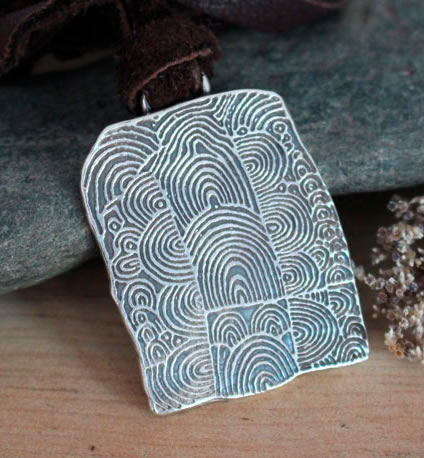
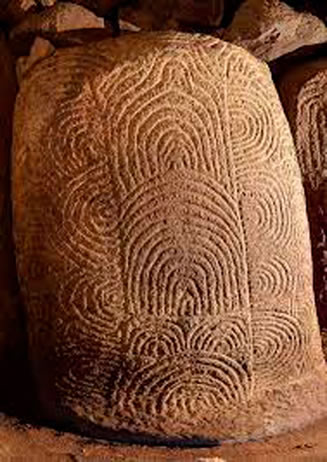
The "Menhir of the lady of Saint Sernin" pendant takes us back to the 3rd millennium BC, showcasing a remarkable stele located in Saint-Sernin-sur-Rance, in the Aveyron department of France. This anthropomorphic stele, dating from the late Neolithic period, represents a female figure with a face engraved with complex patterns, offering a fascinating glimpse into the life and customs of prehistoric Bronze Age societies.
The stele is particularly notable for its rare depiction of a human figure, specifically a woman. The facial tattoo patterns have inspired numerous interpretations. Some researchers suggest that these markings may have had a ritual or symbolic function, related to spiritual beliefs or specific religious practices.
This stele also reflects the significance placed on women in Celtic societies, where they could hold various and influential roles. Archaeological findings indicate that women could serve as priestesses (druidesses), warriors, as well as leaders and advisors. The presence of this anthropomorphic stele highlights the recognition of these important roles and the significant place women occupied in these ancient societies.
In creating this pendant, we aimed to capture not only the beauty and complexity of this ancient artwork but also to honor the memory of these female figures who shaped early European cultures.
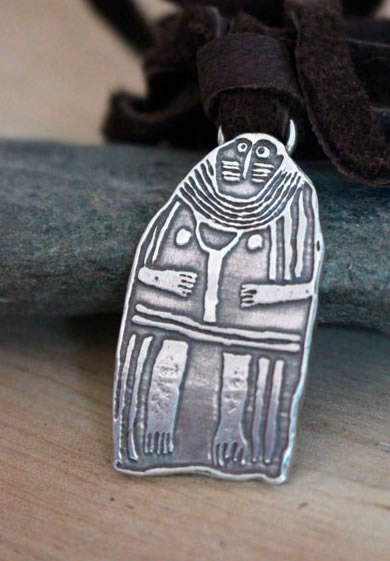
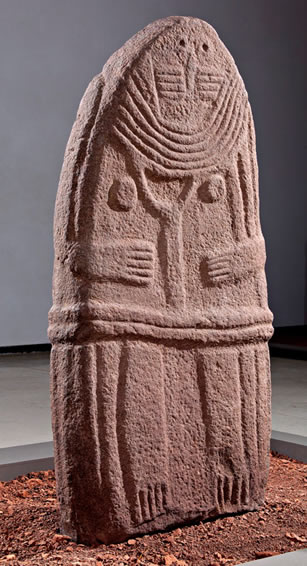
To discover our Neolithic Cucuteni Venus, we embarked on a journey to Eastern Europe, between Ukraine and Romania, where we discovered this Mother Goddess, dating from between 4050 and 3900 BC, belonging to the Cucuteni culture, one of the most advanced civilizations of its time. This culture, also known as Cucuteni-Trypillia, is remarkable for its advances in agriculture, its communal complexes, and its artistic achievements.
The Venus of Drăguşeni, along with other similar figurines discovered in the region, not only illustrates the veneration of fertility but also the sophistication of religious and artistic practices of the Cucuteni culture. Preserved at the Botoşani County Museum in Moldova, Romania, this terracotta figurine is a valuable testament to how these ancient societies perceived and honored the forces of nature and fertility.
The Cucuteni Venus symbolizes the deep connection between humanity and nature, and the importance of "fertility" for these new urban centers, whose survival depended on the development of agriculture and animal husbandry. These figurines were likely used in rites and ceremonies aimed at ensuring the prosperity of crops and the fertility of women, reflecting the belief in divine aid to guarantee the growth and prosperity of the communities.
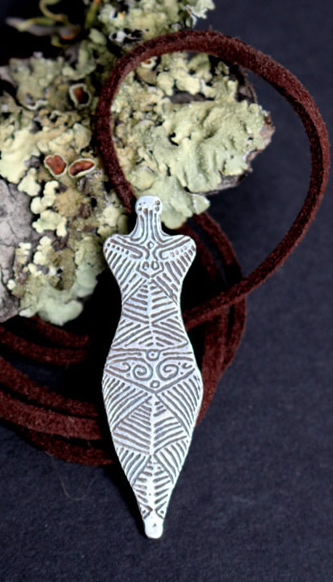
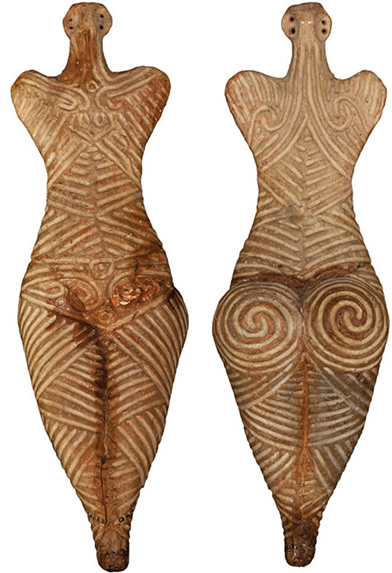
Our Neolithic owl necklace is inspired by a slate tablet found at Cerro de la Cabeza, Valencina de la Concepción, Spain, dating from the Copper Age, between 4500 and 2500 BC. This site, located in the Seville region, is renowned for its archaeological wealth and sophisticated artifacts.
The slate tablets from this period are often adorned with intricate patterns, and this one is no exception. The meticulous and original design of this tablet features an owl, a bird with complex and fascinating symbolism. As a nocturnal creature, the owl is frequently associated with wisdom, inner vision, and protection against evil spirits. In the Neolithic context, it might also be connected to nocturnal deities or spiritual figures responsible for overseeing fertility and the prosperity of the community.
Thus, this tablet could represent a nocturnal fertility goddess, a powerful and mysterious figure who watches over and promotes the growth of crops and the well-being of community members. The choice of this bird as the central motif in our necklace is therefore not only a celebration of Neolithic art and culture but also an evocation of the protective and nurturing role of deities associated with nature and fertility.
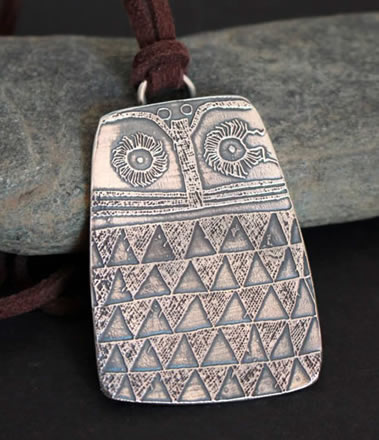
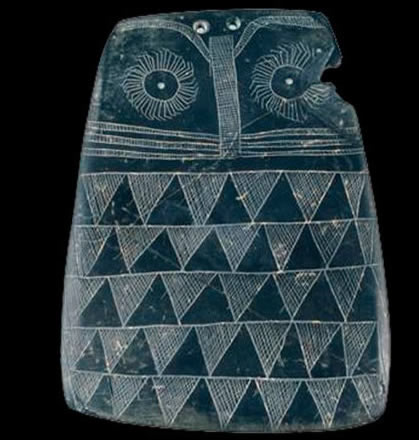
We now take a leap through time, to between 50 BCE and 50 CE, to discover a remarkable object from Celtic Britain: the Desborough Mirror. This type of Celtic bronze artifact is extremely rare outside the British Isles and reflects a distinctive insular tradition. The mirror was discovered in the early 20th century in Northamptonshire, England.
The Desborough Mirror is thought to date from the period known as Insular La Tène—a late phase of British Celtic culture, marked by multiple influences, notably Roman, on the eve of the island’s conquest. It consists of a polished bronze disc forming the reflective surface, extended by an elegantly twisted handle.
We chose to reproduce only the back of the mirror, which is beautifully decorated. It displays typically Celtic motifs: spirals, scrolls, and interlacing patterns unfolding in a masterful balance between textured and untextured areas. This visual interplay seems to echo the nature of reflection and inversion inherent in mirrors, heightening the object’s magical or ritual dimension. The flowing, dynamic design creates a sense of movement and transformation, perhaps reinforcing the idea that the mirror was not merely meant for seeing oneself, but also for seeing beyond—between the visible and invisible worlds.
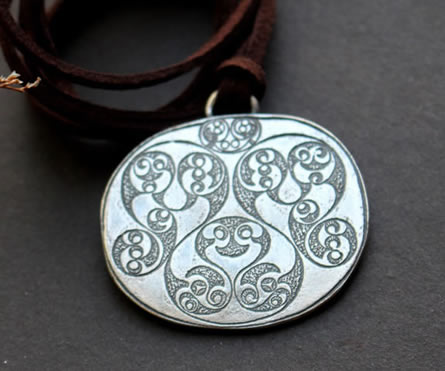
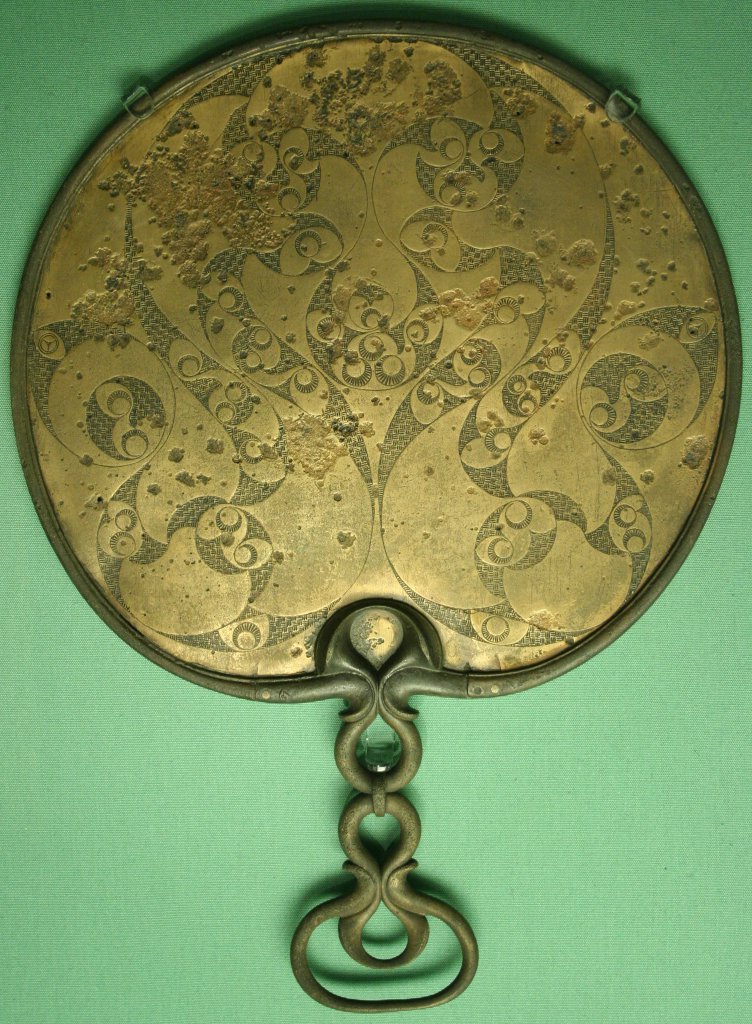
To deepen your knowledge of the art and history of neolithic, we recommend the following books:
Picts of Scotland jewelry
We took a brief detour to explore the Pictish tribes of northern Scotland, who inhabited the region before the arrival of the Romans. This remarkable people managed to resist Roman conquest and Viking invasions, demonstrating their strength and resilience. Often considered a mysterious and enigmatic group, the Picts left behind numerous archaeological traces and feature prominently in historical accounts.
The Picts were renowned for their craftsmanship, particularly in the creation of jewelry and stone sculptures. Their craftsmanship is distinguished by intricate geometric patterns, mystical symbols, and stylized animal representations, often interpreted as protective symbols or depictions of local deities. These patterns adorn not only their jewelry but also engraved stones and sculpted crosses found in funerary and religious monuments.
Although the Picts were largely assimilated by the Scots during the first millennium AD, their legacy continues to fascinate historians, archaeologists, and enthusiasts of ancient history. Pictish artifacts provide valuable insights into the culture, beliefs, and practices of this ancient people, and their art continues to captivate the modern imagination with its symbolic richness and timeless beauty.
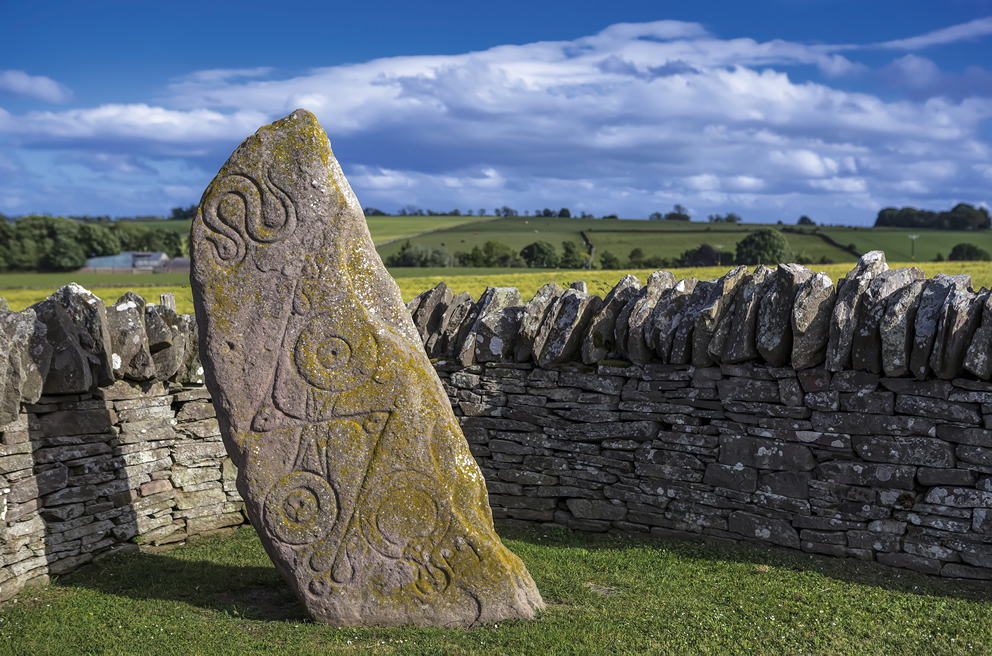
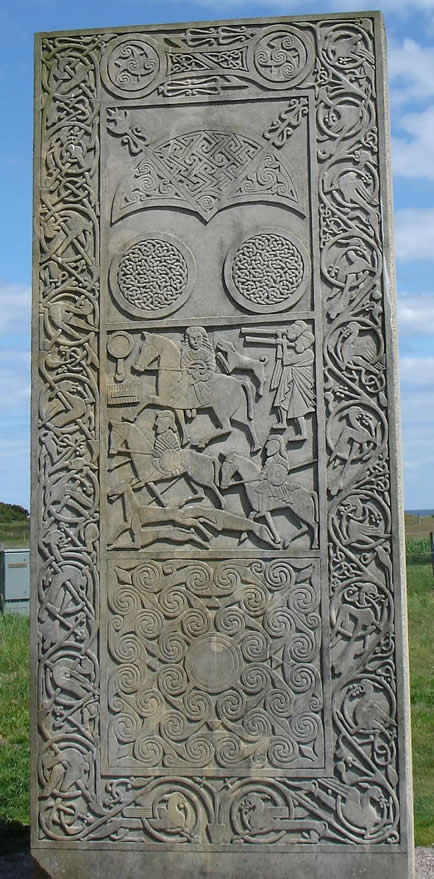
The Picts, a Celtic people who occupied northern Scotland, left behind an impressive archaeological legacy, particularly through their carved stelae and slabs. These ornately decorated stones feature magical motifs, animals, geometric shapes, and scenes from historical or daily life. Over time, these motifs have often been interpreted through the lens of Christianity, reflecting a period of cultural transition.
Among these remarkable stelae, we chose to draw inspiration from the Cadboll Stone, a large carved slab dated around 800 AD, located on the Tarbat Peninsula in Easter Ross, Scotland. This imposing stone stands 2.34 meters tall and weighs approximately 1.9 tons. The main motif of this stone is a dynamic hunting scene, surrounded by traditional Pictish symbols such as spirals, crosses, and interlaced patterns.
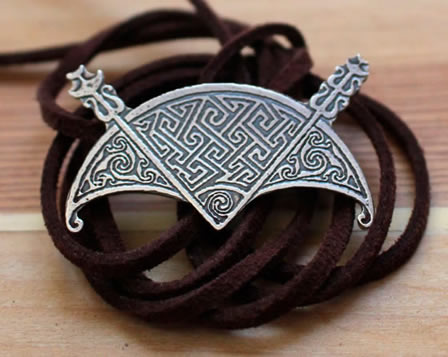
The impressive size of this stela required careful selection for our reproduction to preserve the visibility and integrity of the details. For our necklace, titled "the Cadboll crescent moon," we chose to reproduce only the upper portion of the stela. This section features a stylized crescent moon, intersected by lines that may symbolize broken arrows or movement patterns. This design evokes the connection between the natural and cosmic worlds, a common theme in Pictish art.
By selecting this part of the stela, we pay homage to the complexity and beauty of Pictish art while offering a piece that embodies the rich artistic tradition of this ancient people. This necklace represents a modern interpretation of an ancient symbol, bridging the mysteries of the past with contemporary creations.
To deepen your knowledge of the art and history of Picts, we recommend the following books:
Prehistoric jewelry
Prehistory, that captivating era marking the dawn of humanity, is a period imbued with mystery and resilience. Spanning from the earliest evidence of tool use to the beginnings of historical civilizations, this era is distinguished by the gradual adaptation of humans to their environment and the relentless quest to understand the world around them.
During this time, the first tools, artworks, and religious beliefs emerged, offering fascinating glimpses into the daily lives and spiritual practices of these ancient societies.
Prehistory continues to fascinate and intrigue us, as it not only reminds us of our origins but also of our fundamental connection with nature. By exploring prehistoric art, we gain a deeper understanding of how our ancestors expressed their identity, beliefs, and relationship with their environment through artistic and symbolic creations.

The Rupestre Necklace depicts a typical hunting scene from the prehistoric era, inspired by the cave paintings of Barranc de la Valtorta in the Valencian region of Spain. This artwork, dating back to 10,000 BC, belongs to the Epipaleolithic period and was discovered in the Cave of the Horses (dels Cavalls).
The rock paintings from this period are remarkable for their dynamism and precision, illustrating hunting scenes that not only highlight the skills of prehistoric hunters but also their deep relationship with the animal world. The stylized figures of animals, often accompanied by abstract symbols, offer a fascinating glimpse into the daily lives and spiritual beliefs of these early humans.
The hunting scene reproduced on this necklace captures the essence of the struggle for survival in a still-wild world, showing how prehistoric people tracked and hunted for sustenance. This piece of jewelry is a tribute to their resilience and adaptability, as well as a reflection of their world rich in symbols and myths.
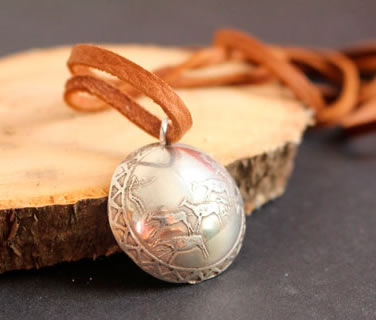
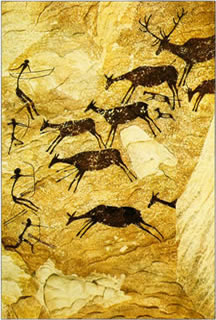
To deepen your knowledge of the art and history of prehistoric time, we recommend the following books:
Native American jewelry
North American Indigenous peoples are a fascinating culture that we also explore. These nomadic tribes, living and traversing vast expanses of land, exemplify life in communion with nature. They respected the seasons and wildlife, taking only what was necessary from nature to survive. Even though much of their beliefs remain unknown today, their creativity undoubtedly captivates.
The Indigenous peoples developed a rich and complex culture, with unique traditions, beliefs, and practices. Their arts, dances, and ceremonies reflect their deep respect for nature and their spiritual connection with the world around them.
Indigenous peoples have also left a lasting legacy in the fields of medicine, agriculture, and craftsmanship. Their knowledge and skills have helped shape the modern world, and their wisdom continues to inspire and guide those who seek to live in harmony with nature. Traditional techniques in weaving, beading, and carving have not only endured through time but have also been adapted and integrated into contemporary art forms, reflecting the richness and resilience of their cultural heritage.
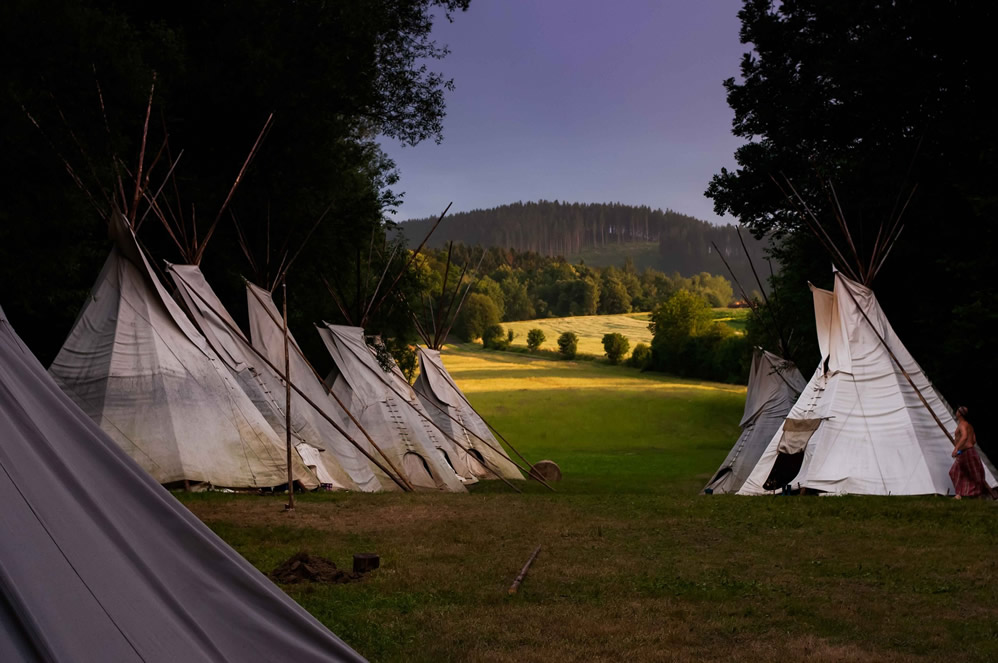
We began our exploration of Northern Indigenous American tribes with the creation of the Yahwera necklace. Its design is inspired by a petroglyph found in the Coso Range Reserve, California. This petroglyph, dating back thousands of years, depicts a complex figure often interpreted as a symbol of spiritual connection and shamanic power.
The motif, which appears to represent a totem animal or spirit guide, immerses us in the shamanic vision of Indigenous peoples. In this tradition, shamans play a crucial role as mediators between the spirit world and the earthly realm. Each symbol in petroglyphs is imbued with deep meanings, representing protective deities or spiritual entities linked to specific aspects of life and nature.
This Indigenous American necklace thus embodies the sacred respect for nature, a fundamental value for many Indigenous tribes. Animals, often seen as spiritual partners, are viewed not only as sources of sustenance but also as spiritual guides, symbolizing the sacred connection between humanity and the animal kingdom. This connection is evident in the way these tribes celebrate and honor nature, integrating spiritual elements into their daily practices.
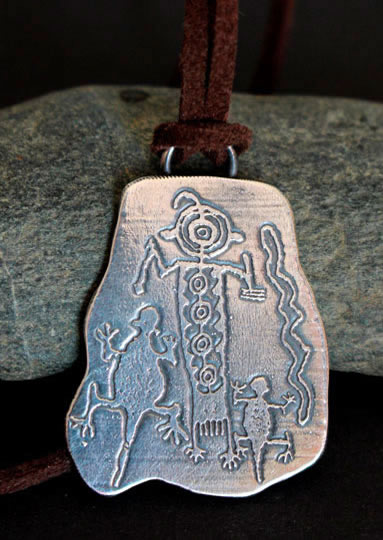
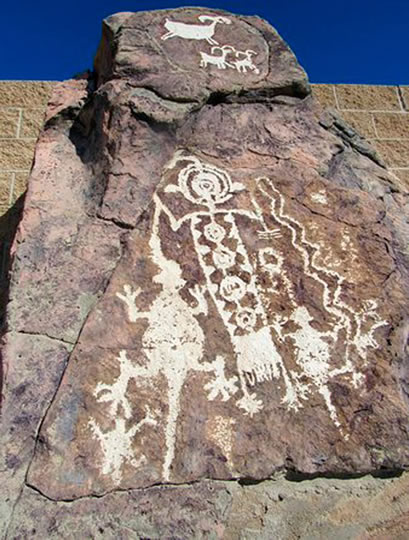
We then traveled to the banks of the Mississippi River to discover a great pre-Hispanic city, challenging the classic—but reductive—image of the fully nomadic North American Indigenous person. This city, covering about 60 hectares, is called Spiro Mounds and is located in Le Flore County, Oklahoma (USA). It was inhabited between the 9th and 15th centuries by a sedentary people who spoke a language from the Caddoan family, like the present-day Wichita, Kichai, Caddo, Pawnee, and Arikara tribes.
Spiro Mounds was part of the vast cultural sphere of the Mississippian civilization—a network of complex societies that built ceremonial earthen mounds, practiced agriculture (especially maize cultivation), and maintained extensive trade networks reaching as far as the Great Lakes, the Rocky Mountains, and the Gulf of Mexico. The Spiro site is especially notable for the richness of the objects uncovered, which bear witness to the influence of a powerful political and religious elite.
From this exploration was born the necklace Spider of Spiro Mounds, inspired by a ritual pendant found in the site's only funerary mound, known as Craig Mound. This pendant, dated between 1200 and 1450 CE, was engraved on a marine shell (Busycon perversum) originating from the Gulf Coast—evidence of long-distance trade. It depicts a stylized spider at the center, surrounded by a circle of engraved human hands.
The spider is seen as a sacred messenger and a weaver of destiny, an ancient symbol of creativity, patience, femininity, and the connection between visible and invisible worlds. In many Native American cultures, the spider also embodies ancestral wisdom and the art of storytelling—she weaves tales as much as she weaves threads. The circle of hands may evoke transmission, collective identity, or the passage from one world to another, especially in a funerary context.
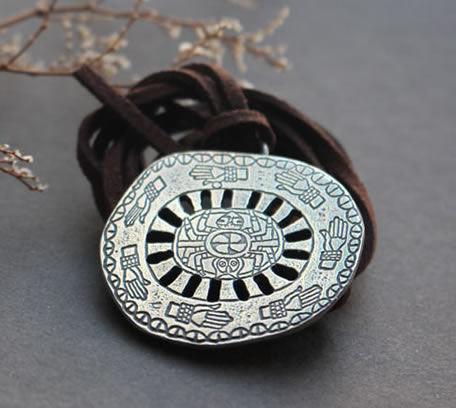
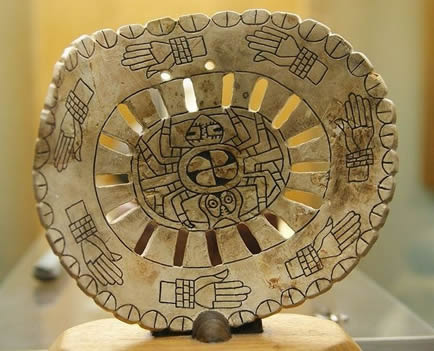
To deepen your knowledge of the art and history of Native American, we recommend the following books:
The Jewelry of the Nomadic Peoples of the Eurasian Steppes
We have been captivated by the nomadic cultures of the Eurasian steppes, which embody a unique vision of freedom and adaptability. These peoples, deeply connected to their horses and the vast expanses they traversed, managed to thrive despite the harsh conditions, such as the intense cold of the steppes. Their lifestyle, often characterized by constant movement and climatic challenges, forged formidable warriors united by an exceptional culture and skills.
The steppes, with their vastness and isolation, provided the backdrop for the emergence of powerful nomadic armies, such as those led by Genghis Khan. These nomads abandoned a sedentary and agricultural way of life around the first millennium BC, opting instead for an extensive pastoral lifestyle. Their mastery of horseback riding, crucial for their survival and military success, enabled them to become elusive warriors, leaving a profound impact on the history of Eurasia.
Over the centuries, various ethnic groups have inhabited these steppes, each contributing its own languages, traditions, and unique contributions. Among these peoples are the Cimmerians, of Iranian or Thracian origin (13th to 8th century BC), the Scythians, also of Iranian origin (9th to 2nd century BC), and the Sarmatians, likewise Iranian (6th to 4th century BC). The Xiongnu, whose origin is uncertain, played a crucial role in the construction of the Great Wall of China, designed to protect the Chinese empire from invasions. Other notable groups include the Kushans (1st century), the Zianbels (156-234), the Hephthalites (6th century), the Huns (4th century), and the Mongols, founded by the legendary Genghis Khan (1206-1368), among many others.
These peoples have not only shaped history through their conquests but also through their rich and diverse culture, molded by the vast expanses of the Eurasian steppes.
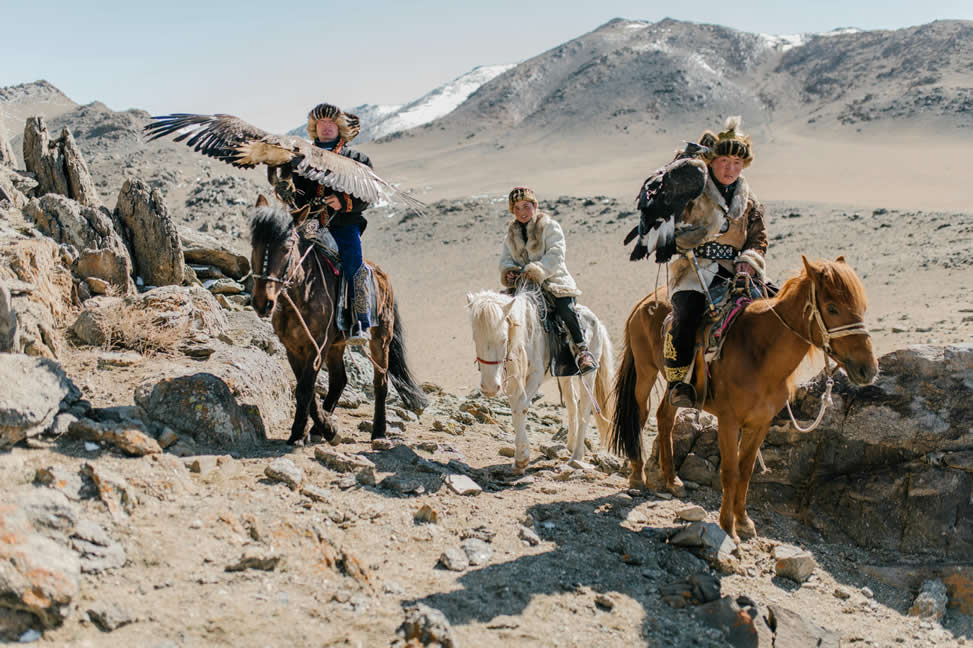
We began our exploration of the Eurasian steppes by focusing on a central symbol of these cultures: the deer. In the early periods of steppe cultures, the deer was one of the most common representations across various artistic media, before being gradually replaced by predatory animals, notably the wolf. Despite its prevalence, the exact significance of the deer remains open to interpretation. It is clear that it served as a totemic guide, often associated with profound spiritual functions. The frequency of its representations in funerary contexts and certain legends suggests that the deer was seen as a soul guide, protecting and accompanying souls on their journey to the heavens.
For our first depiction of the deer, we turned to the famous Altaï princess, whose tattoos provide valuable clues about the role of the deer in this culture. We chose to focus on a particular tattoo from this Pazyryk culture mummy. This tattoo features an animal with attributes such as antlers ending in flowers and a curved horn, which has led to debates about its precise identification: deer or a mythical creature resembling a Capricorn-griffin. The animal’s hind legs, oriented upwards, reinforce the idea that this being is floating, like a soul guide.
This tattoo, along with other artifacts found in steppe tombs, illustrates the importance of the deer in the spiritual and artistic imagination of nomadic peoples. The meticulous details and complex iconography of these representations reveal how revered and sacred this animal was. As a totem, the deer likely symbolized the connection between the world of the living and that of the spirits, playing a crucial role in funerary rites and beliefs about the afterlife. Jewelry inspired by these ancestral motifs helps preserve and honor this sacred connection.
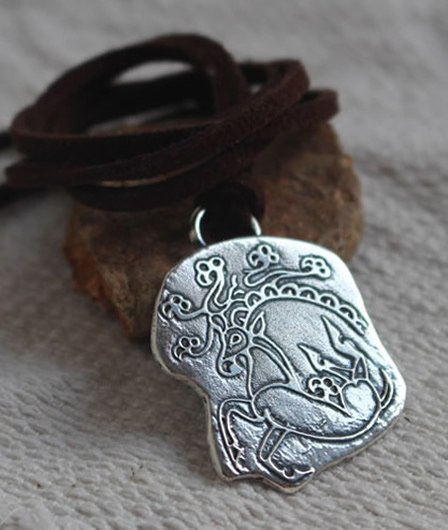
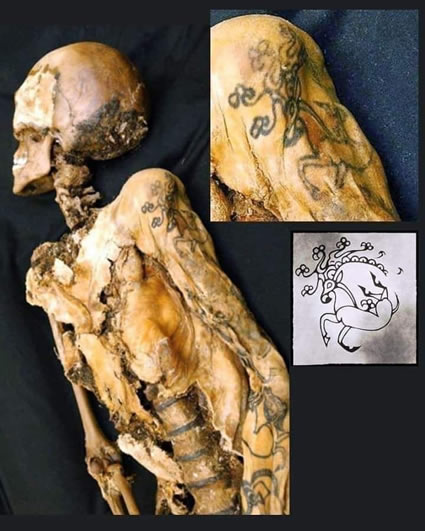
To deepen your knowledge of the art and history of Native American, we recommend the following books:
Invitation to creation
We sincerely hope that this fascinating journey through ancient civilizations and diverse cultures, which we have shared with you, has sparked your curiosity and inspired your imagination as much as it has inspired us.
We warmly invite you to join this creative adventure by sharing with us the works, motifs, or inspirations that captivate you. Your unique vision and suggestions can pave the way for new perspectives and perhaps even new creations that will enrich our collective understanding of ancient cultures.
We acknowledge that our quest for knowledge is far from complete. Each exchange and collaboration is a valuable opportunity to learn and grow together. It is through this sharing of interests and passions that we believe we can make wonderful discoveries and collaborations, and revive the magic of ancient arts and traditions.
We thank you in advance for your enthusiasm and contribution, and we look forward to discovering with you what the future holds in terms of creativity and innovation.




